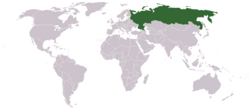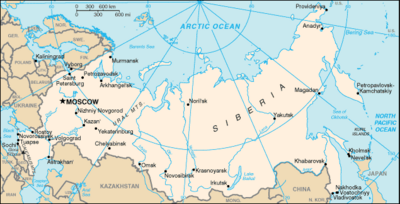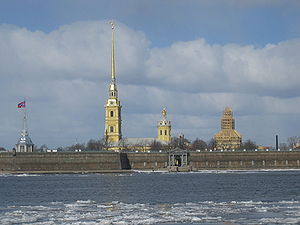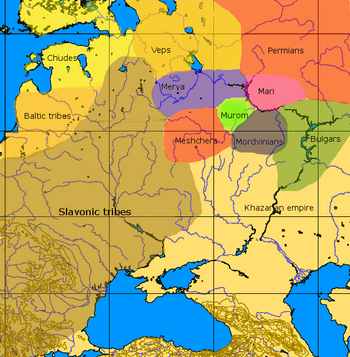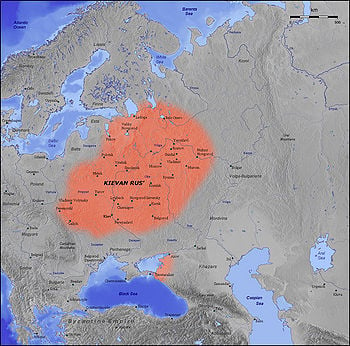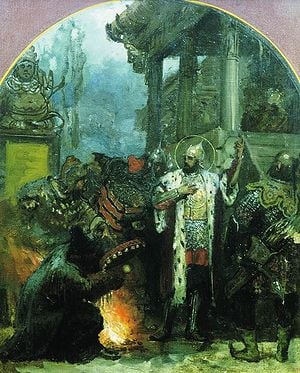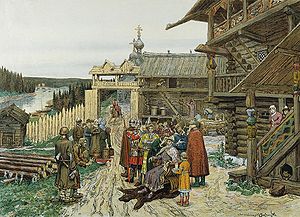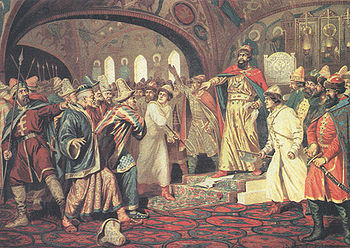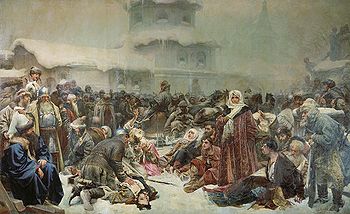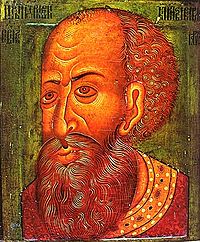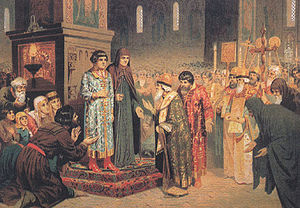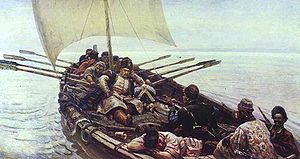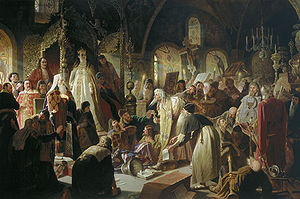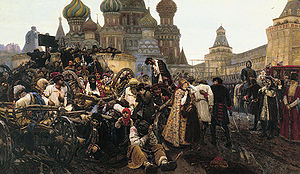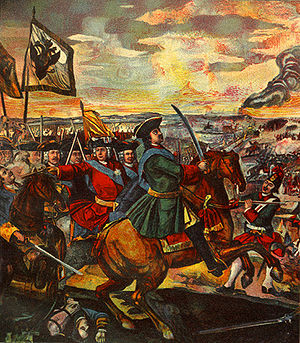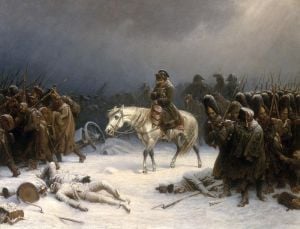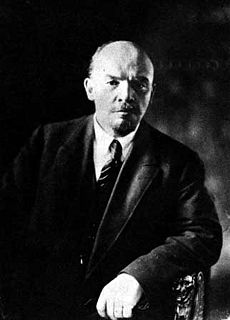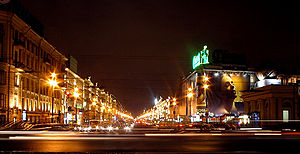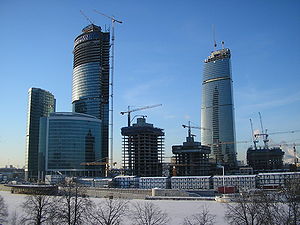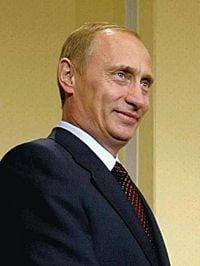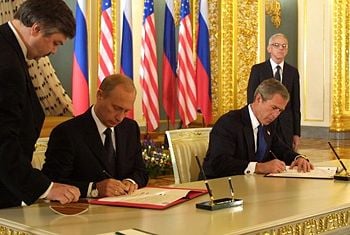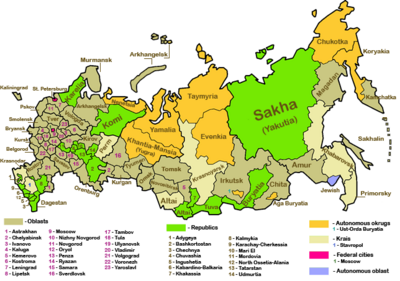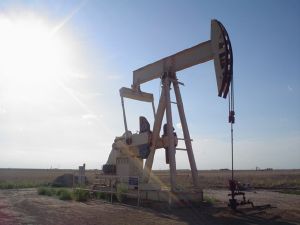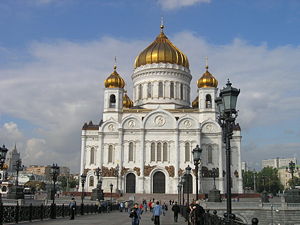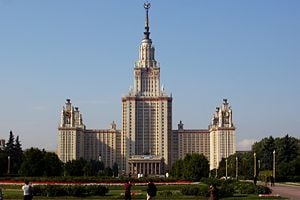Difference between revisions of "Russian Federation" - New World Encyclopedia
Mike Butler (talk | contribs) |
Mike Butler (talk | contribs) |
||
| Line 127: | Line 127: | ||
By the end of the tenth century, the [[Old Norse language|Norse]] minority had merged with the Slavic population, particularly among the aristocracy, which also absorbed [[Ancient Greece|Greek]] [[Christianity|Christian]] influences in the course of the multiple campaigns to loot [[Tsargrad]], or [[Constantinople]]. One such campaign claimed the life of the foremost Slavic [[druzhina]] leader, [[Svyatoslav I]], who was renowned for having crushed the power of the Khazars on the Volga. While the fortunes of the [[Byzantine Empire]] had been ebbing, its culture was a continuous influence on the development of Russia in its formative centuries. | By the end of the tenth century, the [[Old Norse language|Norse]] minority had merged with the Slavic population, particularly among the aristocracy, which also absorbed [[Ancient Greece|Greek]] [[Christianity|Christian]] influences in the course of the multiple campaigns to loot [[Tsargrad]], or [[Constantinople]]. One such campaign claimed the life of the foremost Slavic [[druzhina]] leader, [[Svyatoslav I]], who was renowned for having crushed the power of the Khazars on the Volga. While the fortunes of the [[Byzantine Empire]] had been ebbing, its culture was a continuous influence on the development of Russia in its formative centuries. | ||
| − | + | [[Image:sophia iznutri.jpg|thumb|left|300px|The Byzantine influence on Russian architecture is evident in [[Saint Sophia Cathedral in Kiev|Hagia Sophia in Kiev]], originally built in the 11th century by [[Yaroslav the Wise]].]] | |
Kievan Rus' is important for its introduction of a Slavic variant of the [[Eastern Orthodoxy|Eastern Orthodox]] religion, dramatically deepening a synthesis of Byzantine and Slavic cultures that defined Russian culture for the next thousand years. The region adopted [[Christianity]] in 988 by the official act of public [[Baptism of Kievan Rus'|baptism]] of Kiev inhabitants by [[Vladimir I of Kiev|Prince Vladimir I]]. Some years later the first code of laws, [[Russkaya Pravda]], was introduced. From the onset the Kievan princes followed the Byzantine example and kept the Church dependent on them, even for its revenues, so that the Russian Church and state were always closely linked. | Kievan Rus' is important for its introduction of a Slavic variant of the [[Eastern Orthodoxy|Eastern Orthodox]] religion, dramatically deepening a synthesis of Byzantine and Slavic cultures that defined Russian culture for the next thousand years. The region adopted [[Christianity]] in 988 by the official act of public [[Baptism of Kievan Rus'|baptism]] of Kiev inhabitants by [[Vladimir I of Kiev|Prince Vladimir I]]. Some years later the first code of laws, [[Russkaya Pravda]], was introduced. From the onset the Kievan princes followed the Byzantine example and kept the Church dependent on them, even for its revenues, so that the Russian Church and state were always closely linked. | ||
| − | |||
By the eleventh century, particularly during the reign of [[Yaroslav the Wise]], Kievan Rus' could boast an economy and achievements in architecture and literature superior to those that then existed in the western part of the continent. Compared with the languages of European Christendom, the [[Russian language]] was little influenced by the [[Greek language|Greek]] and [[Latin]] of early Christian writings. This was due to the fact that [[Church Slavonic]] was used directly in [[liturgy]] instead. | By the eleventh century, particularly during the reign of [[Yaroslav the Wise]], Kievan Rus' could boast an economy and achievements in architecture and literature superior to those that then existed in the western part of the continent. Compared with the languages of European Christendom, the [[Russian language]] was little influenced by the [[Greek language|Greek]] and [[Latin]] of early Christian writings. This was due to the fact that [[Church Slavonic]] was used directly in [[liturgy]] instead. | ||
| Line 144: | Line 143: | ||
===Russo-Tatar relations=== | ===Russo-Tatar relations=== | ||
| − | [[Image:Batukhan.jpg|thumb|left|300px| | + | [[Image:Batukhan.jpg|thumb|left|300px|[[Alexander Nevsky]] in the [[Golden Horde|Horde]].]] |
| − | + | [[Image:Semiradsky Aleksandr Nevsky v Orde.jpg|thumb|right|300px|Prince Michael of Chernigov was ordered to worship fire at the camp of Batu Khan. Mongols stabbed him to death for his refusal to renounce [[Christianity]] and take part in the pagan ritual.]] | |
| − | |||
After the fall of the [[Khazars]] in the tenth century, the middle Volga came to be dominated by the mercantile state of [[Volga Bulgaria]], the last vestige of [[Great Bulgaria|Greater Bulgaria]] centered at [[Phanagoria]]. In the tenth century, the Turkic population of Volga Bulgaria converted to [[Islam]], which facilitated its trade with the Middle East and Central Asia. In the wake of the [[Mongol invasion of Volga Bulgaria|Mongol invasions]] of the 1230s, Volga Bulgaria was absorbed by the [[Golden Horde]] and its population evolved into the modern [[Chuvash]]es and [[Tatars|Kazan Tatar]]s. | After the fall of the [[Khazars]] in the tenth century, the middle Volga came to be dominated by the mercantile state of [[Volga Bulgaria]], the last vestige of [[Great Bulgaria|Greater Bulgaria]] centered at [[Phanagoria]]. In the tenth century, the Turkic population of Volga Bulgaria converted to [[Islam]], which facilitated its trade with the Middle East and Central Asia. In the wake of the [[Mongol invasion of Volga Bulgaria|Mongol invasions]] of the 1230s, Volga Bulgaria was absorbed by the [[Golden Horde]] and its population evolved into the modern [[Chuvash]]es and [[Tatars|Kazan Tatar]]s. | ||
| Line 162: | Line 160: | ||
===Ivan III, the Great=== | ===Ivan III, the Great=== | ||
| − | [[Image:Kivshenko Ivan III tears off the khans missive letter.jpg|thumb|right| | + | [[Image:Kivshenko Ivan III tears off the khans missive letter.jpg|thumb|right|350px|Ivan III tears off the Khan's missive letter demanding the tribute in from of Khan's mission]] |
In the fifteenth century, the grand princes of Moscow went on gathering Russian lands to increase the population and wealth under their rule. The most successful practitioner of this process was [[Ivan III of Russia|Ivan III]], the Great (1462–1505), who laid the foundations for a Russian national state. Ivan competed with his powerful northwestern rival, the [[Grand Duchy of Lithuania]], for control over some of the semi-independent [[Upper Principalities]] in the upper Dnieper and [[Oka River]] basins. | In the fifteenth century, the grand princes of Moscow went on gathering Russian lands to increase the population and wealth under their rule. The most successful practitioner of this process was [[Ivan III of Russia|Ivan III]], the Great (1462–1505), who laid the foundations for a Russian national state. Ivan competed with his powerful northwestern rival, the [[Grand Duchy of Lithuania]], for control over some of the semi-independent [[Upper Principalities]] in the upper Dnieper and [[Oka River]] basins. | ||
Through the defections of some princes, border skirmishes, and a long war with the Novgorod Republic, Ivan III was able to annex Novgorod and Tver. As a result, the [[Grand Duchy of Moscow]] tripled in size under his rule. During his conflict with Pskov, a monk named [[Filofei]] (Philotheus of Pskov) composed a letter to Ivan III, with the prophecy that the latter's kingdom will be the [[Third Rome]]. The [[Fall of Constantinople]] and the death of the last Greek Orthodox Christian emperor contributed to this new idea of Moscow as 'New Rome' and the seat of Orthodox Christianity. | Through the defections of some princes, border skirmishes, and a long war with the Novgorod Republic, Ivan III was able to annex Novgorod and Tver. As a result, the [[Grand Duchy of Moscow]] tripled in size under his rule. During his conflict with Pskov, a monk named [[Filofei]] (Philotheus of Pskov) composed a letter to Ivan III, with the prophecy that the latter's kingdom will be the [[Third Rome]]. The [[Fall of Constantinople]] and the death of the last Greek Orthodox Christian emperor contributed to this new idea of Moscow as 'New Rome' and the seat of Orthodox Christianity. | ||
| − | [[Image:LebedevK UnichNovgrodVecha.jpg|thumb|left| | + | [[Image:LebedevK UnichNovgrodVecha.jpg|thumb|left|350px|Fall of [[Novgorod Republic]] in 1478. On the right stands the last leader of the Republic, [[Marfa Boretskaya]] ]] |
A contemporary of the [[Tudor dynasty|Tudor]]s and other "new monarchs" in Western Europe, Ivan proclaimed his absolute sovereignty over all Russian princes and nobles. Refusing further tribute to the Tatars, Ivan initiated a series of attacks that opened the way for the complete defeat of the declining Golden Horde, now divided into several khanates and hordes. Ivan and his successors sought to protect the southern boundaries of their domain against attacks of the [[Khanate of Crimea|Crimean Tatars]] and other hordes. To achieve this aim, they sponsored the construction of the [[Great Abatis Belt]] and granted manors to nobles, who were obliged to serve in the military. The manor system provided a basis for an emerging horse army. | A contemporary of the [[Tudor dynasty|Tudor]]s and other "new monarchs" in Western Europe, Ivan proclaimed his absolute sovereignty over all Russian princes and nobles. Refusing further tribute to the Tatars, Ivan initiated a series of attacks that opened the way for the complete defeat of the declining Golden Horde, now divided into several khanates and hordes. Ivan and his successors sought to protect the southern boundaries of their domain against attacks of the [[Khanate of Crimea|Crimean Tatars]] and other hordes. To achieve this aim, they sponsored the construction of the [[Great Abatis Belt]] and granted manors to nobles, who were obliged to serve in the military. The manor system provided a basis for an emerging horse army. | ||
| Line 173: | Line 171: | ||
===Ivan IV, the Terrible=== | ===Ivan IV, the Terrible=== | ||
| − | [[Image:Kremlinpic4.jpg|thumb|right| | + | [[Image:Kremlinpic4.jpg|thumb|right|200px|Ivan IV, the Terrible.]] |
The development of the Tsar's autocratic powers reached a peak during the reign (1547–1584) of [[Ivan IV of Russia|Ivan IV]] ("Ivan the Terrible"). He strengthened the position of the monarch to an unprecedented degree, as he ruthlessly subordinated the nobles to his will, exiling or executing many on the slightest provocation. Nevertheless, Ivan is often seen a farsighted statesman who reformed Russia as he promulgated a new code of laws ([[Sudebnik of 1550]]), established the first Russian feudal representative body ([[Zemsky Sobor]]), curbed the influence of clergy, and introduced the local self-management in rural regions. | The development of the Tsar's autocratic powers reached a peak during the reign (1547–1584) of [[Ivan IV of Russia|Ivan IV]] ("Ivan the Terrible"). He strengthened the position of the monarch to an unprecedented degree, as he ruthlessly subordinated the nobles to his will, exiling or executing many on the slightest provocation. Nevertheless, Ivan is often seen a farsighted statesman who reformed Russia as he promulgated a new code of laws ([[Sudebnik of 1550]]), established the first Russian feudal representative body ([[Zemsky Sobor]]), curbed the influence of clergy, and introduced the local self-management in rural regions. | ||
| Line 184: | Line 182: | ||
===Time of Troubles=== | ===Time of Troubles=== | ||
| − | [[Image:Makovsky 1896.jpg|thumb| | + | [[Image:Makovsky 1896.jpg|thumb|right|300px|Kuzma Minin appeals to the people of [[Nizhny Novgorod]] to raise a volunteer army against the Poles.]] |
The death of Ivan's childless son [[Feodor I of Russia|Feodor]] was followed by a period of civil wars and foreign intervention known as the "[[Time of Troubles]]" (1606–13). Extremely cold summer (1601-1603) wrecked crops, that led to the famine and increased the social disorganization. [[Boris Godunov]]'s reign ended in chaos, civil war combined with foreign intrusion, devastation of many cities and depopulation of the rural regions. The country rocked by internal chaos also attracted several waves of interventions by [[Polish-Lithuanian Commonwealth]]. The invaders reached Moscow and installed, first, the impostor [[False Dmitriy I]] and, later, a Polish prince [[Władysław IV Vasa]] on the Russian throne. Moscow population revolted but the riots were brutally suppressed and the city was set on fire. | The death of Ivan's childless son [[Feodor I of Russia|Feodor]] was followed by a period of civil wars and foreign intervention known as the "[[Time of Troubles]]" (1606–13). Extremely cold summer (1601-1603) wrecked crops, that led to the famine and increased the social disorganization. [[Boris Godunov]]'s reign ended in chaos, civil war combined with foreign intrusion, devastation of many cities and depopulation of the rural regions. The country rocked by internal chaos also attracted several waves of interventions by [[Polish-Lithuanian Commonwealth]]. The invaders reached Moscow and installed, first, the impostor [[False Dmitriy I]] and, later, a Polish prince [[Władysław IV Vasa]] on the Russian throne. Moscow population revolted but the riots were brutally suppressed and the city was set on fire. | ||
| Line 192: | Line 190: | ||
===Early Romanovs=== | ===Early Romanovs=== | ||
| − | [[Image:Kivchenko Election of Mikhail Romanov.jpg|thumb| | + | [[Image:Kivchenko Election of Mikhail Romanov.jpg|thumb|300px|left|Election of 16-year-old Mikhail Romanov, the first Tsar of the Romanov dynasty.]] |
In February, 1613, with the chaos ended and the Poles expelled from Moscow, a [[Zemsky Sobor|national assembly]], composed of representatives from 50 cities and even some peasants, elected [[Michael I of Russia|Michael Romanov]], the young son of [[Patriarch Filaret]], to the throne. The [[Romanov]] dynasty ruled Russia until 1917. | In February, 1613, with the chaos ended and the Poles expelled from Moscow, a [[Zemsky Sobor|national assembly]], composed of representatives from 50 cities and even some peasants, elected [[Michael I of Russia|Michael Romanov]], the young son of [[Patriarch Filaret]], to the throne. The [[Romanov]] dynasty ruled Russia until 1917. | ||
The immediate task of the new dynasty was to restore peace. Fortunately for Moscow, its major enemies, the [[Polish-Lithuanian Commonwealth]] and [[Sweden]], were engaged in a bitter conflict with each other, which provided Russia the opportunity to make peace with Sweden in 1617 and to sign a truce with the Polish-Lithuanian Commonwealth in 1619. Recovery of lost territories started in the mid-seventeenth century, when the [[Chmielnicki Uprising|Khmelnitsky Uprising]] in Ukraine against the | The immediate task of the new dynasty was to restore peace. Fortunately for Moscow, its major enemies, the [[Polish-Lithuanian Commonwealth]] and [[Sweden]], were engaged in a bitter conflict with each other, which provided Russia the opportunity to make peace with Sweden in 1617 and to sign a truce with the Polish-Lithuanian Commonwealth in 1619. Recovery of lost territories started in the mid-seventeenth century, when the [[Chmielnicki Uprising|Khmelnitsky Uprising]] in Ukraine against the | ||
| − | |||
| − | |||
[[Image:surikov1906.jpg|thumb|right|300px|Stenka Razin Sailing in the Caspian]] | [[Image:surikov1906.jpg|thumb|right|300px|Stenka Razin Sailing in the Caspian]] | ||
| − | [[Image:Nikita Pustosviat. Dispute on the Confession of Faith.jpg|thumb|right| 300px| | + | [[Image:Nikita Pustosviat. Dispute on the Confession of Faith.jpg|thumb|right|300px|Patriarch Nikon's reform of the church service caused schism in the Russian Orthodox Church and appearance of Old Believers.]] |
Polish rule brought about the [[Treaty of Pereyaslav]] concluded between Russia and the [[Ukrainian Cossacks]]. According to the treaty, Russia granted protection to the [[Cossack Hetmanate|Cossacks state]] in the [[Left-bank Ukraine]], formerly under the Polish control. This triggered a prolonged [[Russo-Polish War (1654-1667)|Russo-Polish War]] which ended with the [[Treaty of Andrusovo]] (1667) were Poland accepted the loss of Left-bank Ukraine, [[Kiev]] and [[Smolensk]]. | Polish rule brought about the [[Treaty of Pereyaslav]] concluded between Russia and the [[Ukrainian Cossacks]]. According to the treaty, Russia granted protection to the [[Cossack Hetmanate|Cossacks state]] in the [[Left-bank Ukraine]], formerly under the Polish control. This triggered a prolonged [[Russo-Polish War (1654-1667)|Russo-Polish War]] which ended with the [[Treaty of Andrusovo]] (1667) were Poland accepted the loss of Left-bank Ukraine, [[Kiev]] and [[Smolensk]]. | ||
Rather than risk their estates in more civil war, the great nobles or ''[[boyar]]s'' cooperated with the first Romanovs, enabling them to finish the work of bureaucratic centralization. Thus, the state required service from both the old and the new nobility, primarily in the military. In return the tsars allowed the ''boyars'' to complete the process of enserfing the peasants. | Rather than risk their estates in more civil war, the great nobles or ''[[boyar]]s'' cooperated with the first Romanovs, enabling them to finish the work of bureaucratic centralization. Thus, the state required service from both the old and the new nobility, primarily in the military. In return the tsars allowed the ''boyars'' to complete the process of enserfing the peasants. | ||
| + | |||
===Peasants rebel=== | ===Peasants rebel=== | ||
In the preceding century, the state had gradually curtailed peasants' rights to move from one landlord to another. With the state now fully sanctioning [[Russian serfdom|serfdom]], runaway peasants became state fugitives, and the power of the landlords over the peasants "attached" to their land have become almost complete. Together the state and the nobles placed the overwhelming burden of taxation on the peasants, whose rate was 100 times greater in the mid-seventeenth century than it had been a century earlier. In addition, middle-class urban tradesmen and craftsmen were assessed taxes, and, like the serfs, they were forbidden to change residence. All segments of the population were subject to military levy and to special taxes. | In the preceding century, the state had gradually curtailed peasants' rights to move from one landlord to another. With the state now fully sanctioning [[Russian serfdom|serfdom]], runaway peasants became state fugitives, and the power of the landlords over the peasants "attached" to their land have become almost complete. Together the state and the nobles placed the overwhelming burden of taxation on the peasants, whose rate was 100 times greater in the mid-seventeenth century than it had been a century earlier. In addition, middle-class urban tradesmen and craftsmen were assessed taxes, and, like the serfs, they were forbidden to change residence. All segments of the population were subject to military levy and to special taxes. | ||
| Line 209: | Line 206: | ||
===Peter the Great=== | ===Peter the Great=== | ||
| − | [[Image:Surikov streltsi.jpg|thumb|right|300px|Peter I disbanded the old | + | [[Image:Surikov streltsi.jpg|thumb|right|300px|Peter I disbanded the old ''streltzi'' army. Thousands of streltzi were executed after their mutiny.]] |
[[Peter I of Russia|Peter I]], the Great (1672–1725), consolidated autocracy in Russia and played a major role in bringing his country into the European state system. From its modest beginnings in the fourteenth century principality of Moscow, Russia had become the largest state in the world by Peter's time. Three times the size of continental Europe, it spanned the Eurasian landmass from the [[Baltic Sea]] to the Pacific Ocean. Much of its expansion had taken place in the seventeenth century, culminating in the first Russian settlement of the Pacific in the mid-seventeenth century, the reconquest of Kiev, and the pacification of the Siberian tribes. However, this vast land had a population of only 14 million. Grain yields trailed behind those of agriculture in the West (that can be partly explained by the heavier climatic conditions, in particular long cold winters and short vegetative period compelling almost the entire population to farm. Only a small fraction of the population lived in the towns. Russia remained isolated from the sea trade, its internal trade communications and many manufactures were dependent on the seasonal changes. | [[Peter I of Russia|Peter I]], the Great (1672–1725), consolidated autocracy in Russia and played a major role in bringing his country into the European state system. From its modest beginnings in the fourteenth century principality of Moscow, Russia had become the largest state in the world by Peter's time. Three times the size of continental Europe, it spanned the Eurasian landmass from the [[Baltic Sea]] to the Pacific Ocean. Much of its expansion had taken place in the seventeenth century, culminating in the first Russian settlement of the Pacific in the mid-seventeenth century, the reconquest of Kiev, and the pacification of the Siberian tribes. However, this vast land had a population of only 14 million. Grain yields trailed behind those of agriculture in the West (that can be partly explained by the heavier climatic conditions, in particular long cold winters and short vegetative period compelling almost the entire population to farm. Only a small fraction of the population lived in the towns. Russia remained isolated from the sea trade, its internal trade communications and many manufactures were dependent on the seasonal changes. | ||
| Line 221: | Line 218: | ||
=== Catherine the Great=== | === Catherine the Great=== | ||
| − | [[Image:SPB Monument of Catherine II 1890-1900.jpg|thumb|left| | + | [[Image:SPB Monument of Catherine II 1890-1900.jpg|thumb|left|250px|The monument to [[Catherine II]] in [[Saint Petersberg]]]] |
Nearly forty years were to pass before a comparably ambitious and ruthless ruler appeared on the Russian throne. [[Catherine II of Russia|Catherine II]], the Great, was a German princess who married the German heir to the Russian crown. Finding him incompetent, Catherine tacitly consented to his murder. It was announced that he had died of "[[apoplexy]]", and in 1762 she became ruler. | Nearly forty years were to pass before a comparably ambitious and ruthless ruler appeared on the Russian throne. [[Catherine II of Russia|Catherine II]], the Great, was a German princess who married the German heir to the Russian crown. Finding him incompetent, Catherine tacitly consented to his murder. It was announced that he had died of "[[apoplexy]]", and in 1762 she became ruler. | ||
| Line 228: | Line 225: | ||
Catherine the Great extended Russian political control over the Polish-Lithuanian Commonwealth with actions including the support of the [[Targowica Confederation]], although the cost of her campaigns, on top of the oppressive social system that required lords' serfs to spend almost all of their time laboring on the lords' land, provoked a major peasant uprising in 1773, after Catherine legalized the selling of serfs separate from land. Inspired by another Cossack named [[Yemelyan Pugachev|Pugachev]], with the emphatic cry of "Hang all the landlords!" the rebels threatened to take Moscow before they were ruthlessly suppressed. Catherine had Pugachev drawn and quartered in [[Red Square]], but the specter of revolution continued to haunt her and her successors. | Catherine the Great extended Russian political control over the Polish-Lithuanian Commonwealth with actions including the support of the [[Targowica Confederation]], although the cost of her campaigns, on top of the oppressive social system that required lords' serfs to spend almost all of their time laboring on the lords' land, provoked a major peasant uprising in 1773, after Catherine legalized the selling of serfs separate from land. Inspired by another Cossack named [[Yemelyan Pugachev|Pugachev]], with the emphatic cry of "Hang all the landlords!" the rebels threatened to take Moscow before they were ruthlessly suppressed. Catherine had Pugachev drawn and quartered in [[Red Square]], but the specter of revolution continued to haunt her and her successors. | ||
| − | |||
[[Image:Napoleons retreat from moscow.jpg|thumb|right|300px|Napoleon's retreat from Moscow]] | [[Image:Napoleons retreat from moscow.jpg|thumb|right|300px|Napoleon's retreat from Moscow]] | ||
Catherine successfully waged war against the decaying Ottoman Empire and advanced Russia's southern boundary to the Black Sea. Then, by allying with the rulers of [[Austrian Empire|Austria]] and [[Prussia]], she incorporated the territories of the Polish-Lithuanian Commonwealth, where after a century of Russian rule non-Catholic mainly Orthodox population prevailed during the [[Partitions of Poland]], pushing the Russian frontier westward into Central Europe. By the time of her death in 1796, Catherine's expansionist policy had made Russia into a major European power. This continued with [[Alexander I of Russia|Alexander I's]] wresting of [[Finland]] from the weakened kingdom of [[Sweden]] in 1809 and of [[Bessarabia]] from the Ottomans in 1812. | Catherine successfully waged war against the decaying Ottoman Empire and advanced Russia's southern boundary to the Black Sea. Then, by allying with the rulers of [[Austrian Empire|Austria]] and [[Prussia]], she incorporated the territories of the Polish-Lithuanian Commonwealth, where after a century of Russian rule non-Catholic mainly Orthodox population prevailed during the [[Partitions of Poland]], pushing the Russian frontier westward into Central Europe. By the time of her death in 1796, Catherine's expansionist policy had made Russia into a major European power. This continued with [[Alexander I of Russia|Alexander I's]] wresting of [[Finland]] from the weakened kingdom of [[Sweden]] in 1809 and of [[Bessarabia]] from the Ottomans in 1812. | ||
| − | + | [[Image:suvorov crossing the alps.jpg|thumb|left|300px|Russian troops under [[Generalissimo]] Suvorov crossing the [[Alps]] in [[1799]]]] | |
[[Napoléon I of France|Napoleon]] made a major misstep when he declared war on Russia after a dispute with Tsar Alexander I and launched an [[Napoleon's invasion of Russia|invasion of Russia]] in 1812. The campaign was a catastrophe. In the bitterly cold Russian weather, thousands of French troops were ambushed and killed by peasant guerrilla fighters. As Napoleon's forces retreated, the Russian troops pursued them into Central and Western Europe and to the gates of Paris. After Russia and its allies defeated Napoleon, Alexander became known as the 'savior of Europe,' and he presided over the redrawing of the map of Europe at the [[Congress of Vienna]] (1815), which made Alexander the monarch of [[Congress Poland]]. | [[Napoléon I of France|Napoleon]] made a major misstep when he declared war on Russia after a dispute with Tsar Alexander I and launched an [[Napoleon's invasion of Russia|invasion of Russia]] in 1812. The campaign was a catastrophe. In the bitterly cold Russian weather, thousands of French troops were ambushed and killed by peasant guerrilla fighters. As Napoleon's forces retreated, the Russian troops pursued them into Central and Western Europe and to the gates of Paris. After Russia and its allies defeated Napoleon, Alexander became known as the 'savior of Europe,' and he presided over the redrawing of the map of Europe at the [[Congress of Vienna]] (1815), which made Alexander the monarch of [[Congress Poland]]. | ||
Revision as of 22:29, 21 August 2007
| Российская Федерация Rossiyskaya Federatsiya Russian Federation |
||||||
|---|---|---|---|---|---|---|
|
||||||
| Motto: none | ||||||
| Anthem: Hymn of the Russian Federation |
||||||
| Capital (and largest city) | Moscow 55°45′N 37°37′E | |||||
| Official languages | Russian | |||||
| Government | Semi-presidential Federal republic | |||||
| - | President of Russia | Vladimir Putin | ||||
| - | Prime Minister | Mikhail Fradkov | ||||
| Independence | from the Soviet Union | |||||
| - | Declared | June 12 1991 | ||||
| - | Finalized | December 25 1991 | ||||
| Area | ||||||
| - | Total | 17,075,400 km² (1st) 6,592,800 sq mi |
||||
| - | Water (%) | 13 | ||||
| Population | ||||||
| - | 2006 estimate | 142,400,000 (7th) | ||||
| - | 2002 census | 145,164,000 | ||||
| GDP (PPP) | 2005 estimate | |||||
| - | Total | $1.576 trillion (10th1) | ||||
| - | Per capita | $11,041 (62nd) | ||||
| Currency | Ruble (RUB) |
|||||
| Time zone | (UTC+2 to +12) | |||||
| - | Summer (DST) | (UTC+3 to +13) | ||||
| Internet TLD | .ru (.su reserved) | |||||
| Calling code | +7 | |||||
| 1 Rank based on April 2006 IMF data. | ||||||
Russia (Rossiya), also the Russian Federation (Росси́йская Федера́ция, Rossiyskaya Federatsiya), is a transcontinental country extending over much of northern Eurasia (Asia and Europe).
The largest country in the world by land area, Russia has the world's ninth-largest population.
Formerly the Russian Soviet Federative Socialist Republic (RSFSR), a republic of the Union of Soviet Socialist Republics (USSR), Russia became the Russian Federation following the dissolution of the Soviet Union in December 1991.
After the Soviet era, the area, population, and industrial production of the Soviet Union (then one of the world's two Cold War superpowers, the other superpower being the United States) that were located in Russia passed on to the Russian Federation.
After the breakup of the Soviet Union, the newly-independent Russian Federation emerged as a great power and is also considered to be an energy superpower. Russia is considered the Soviet Union's successor state in diplomatic matters and is a permanent member of the United Nations Security Council.
It is also one of the five recognised nuclear weapons states and possesses the world's largest stockpile of weapons of mass destruction.
Geography
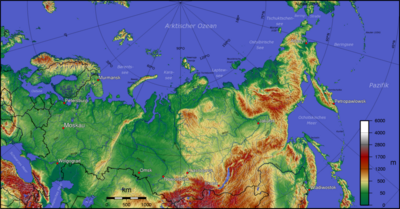
The Russian Federation stretches across much of the north of the supercontinent of Eurasia. Because of its size Russia displays both monotony and diversity. As with its topography, its climates, vegetation, and soils span vast distances.
Russia shares land borders with the following countries (counter-clockwise from northwest to southeast): Norway, Finland, Estonia, Latvia, Lithuania, Poland, Belarus, Ukraine, Georgia, Azerbaijan, Kazakhstan, China, Mongolia, and North Korea. It is also close to the United States (the state of Alaska), Sweden, and Japan across relatively small stretches of water (the Bering Strait, the Baltic Sea, and La Pérouse Strait, respectively).
Russia has an extensive coastline of over 37,000 kilometres (23,000 mi) along the Arctic and Pacific Oceans, as well as the Baltic, Black and Caspian seas. Some smaller bodies of water are part of the open oceans; the Barents Sea, White Sea, Kara Sea, Laptev Sea and East Siberian Sea are part of the Arctic, whereas the Bering Sea, Sea of Okhotsk and the Sea of Japan belong to the Pacific Ocean. Major islands and archipelagos include Novaya Zemlya, the Franz Josef Land, the New Siberian Islands, Wrangel Island, the Kuril Islands and Sakhalin. (See List of islands of Russia). The Diomede Islands (one controlled by Russia, the other by the United States) are just three kilometers (1.9 mi) apart, and Kunashir Island (controlled by Russia but claimed by Japan) is about twenty kilometres (12 mi) from Hokkaidō. With access to three of the world's oceans—the Atlantic, Arctic, and Pacific—Russian fishing fleets are a major contributor to the economy.
With an area of 6,592,800 square miles (17,075,400 square kilometers), Russia is by far the largest country in the world, covering almost twice the total area of the next-largest country, Canada, and has significant mineral and energy resources.
Most of the land consists broad plain with low hills west of Urals, and vast plains in Siberia. These plains are predominantly steppe to the south and heavily forested to the north, with tundra along the northern coast.
Mountain ranges are found along the southern borders, such as the Caucasus (containing Mount Elbrus, Russia's and Europe's highest point at 18,511feet (5642 meters), and the Altai, and in the eastern parts, such as the Verkhoyansk Range or the volcanoes on Kamchatka. The more central Ural Mountains, a north-south range that form the primary divide between Europe and Asia, are also notable.
The lowest point is the Caspian Sea, at 28 meters below sea level.
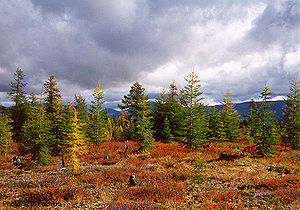
Russia has a largely continental climate because of its sheer size and compact configuration. Most of its land is more than 400 kilometers from the sea, and the center is 3,840 kilometers from the sea. In addition, Russia's mountain ranges, predominantly to the south and the east, block moderating temperatures from the Indian and Pacific Oceans, but European Russia and northern Siberia lack such topographic protection from the Arctic and North Atlantic Oceans. In much of the territory there are only two distinct seasons - winter and summer — spring and autumn are usually brief periods of change between extremely low and extremely high temperatures. The climates of both European and Asian Russia are continental except for the tundra and the extreme southeast. Winters vary from cool along Black Sea coast to frigid in Siberia, while summers vary from warm in the steppes to cool along Arctic coast. A small part of Black Sea coast around Sochi is considered in Russia to have subtropical climate.
Russia is a water-rich country. Russia has thousands of rivers and inland bodies of water, providing it with one of the world's largest surface-water resources. The most prominent of Russia's bodies of fresh water is Lake Baikal, the world's deepest and most capacious freshwater lake. Lake Baikal alone contains over one fifth of the world's liquid fresh surface water. Truly unique on Earth, Baikal is home to more than 1700 species of plants and animals, two thirds of which can be found nowhere else in the world.
Many rivers flow across Russia; see Rivers of Russia. Of its 100,000 rivers, Russia contains some of the world's longest. The Volga is the most famous — not only because it is the longest river in Europe but also because of its major role in Russian history. Major lakes include Lake Baikal, Lake Ladoga and Lake Onega.
Russia has a wide natural resource base including major deposits of petroleum, natural gas, coal, timber and many strategic minerals. Russia has the world's largest forest reserves, which supply lumber, pulp and paper, and raw material for woodworking industries. Formidable obstacles of climate, terrain, and distance hinder exploitation of natural resources.
Permafrost over much of Siberia is a major impediment to development. There is volcanic activity in the Kuril Islands, volcanoes and earthquakes on the Kamchatka Peninsula, and spring floods and summer/autumn forest fires throughout Siberia and parts of European Russia.
From north to south the East European Plain is clad sequentially in tundra, coniferous forest (taiga), mixed forest, broadleaf forest, grassland (steppe), and semidesert (fringing the Caspian Sea) as the changes in vegetation reflect the changes in climate. Siberia supports a similar sequence but lacks the mixed forest. Most of Siberia is taiga. (vast coniferous forest and tundra in Siberia)
air pollution from heavy industry, emissions of coal-fired electric plants, and transportation in major cities; industrial, municipal, and agricultural pollution of inland waterways and seacoasts; deforestation; soil erosion; soil contamination from improper application of agricultural chemicals; scattered areas of sometimes intense radioactive contamination; groundwater contamination from toxic waste; urban solid waste management; abandoned stocks of obsolete pesticides
According to the data of 2002 Russian Census, there are 1108 cities and towns in Russia. Moscow is the capital of Russia and the country's economic, financial, educational, and transportation centre. Located on the Moskva River in the Central Federal District, in the European part of Russia, Moscow's population constitutes about 7 percent of the total Russian population. The first Russian reference to Moscow dates from 1147. Moscow is home to many scientific and educational institutions, as well as numerous sport facilities. It possesses a complex transport system that includes the world's busiest metro system, which is famous for its architecture. Moscow also hosted the 1980 Summer Olympics.
Saint Petersburg, Russia's second major city, is located in the Northwestern Federal District of Russia on the Neva River at the east end of the Gulf of Finland on the Baltic Sea. St. Petersburg's informal name, Piter (Питер), is based on how Peter the Great was called by foreigners. The city's other names were Petrograd and Leningrad. Founded by Tsar Peter the Great in 1703 as a "window to Europe" it was capital of the Russian Empire for more than two hundred years (1712-1728, 1732-1918). St. Petersburg ceased being the capital in 1918 after the Russian Revolution of 1917.
History
Pre-Slavic inhabitants
The vast steppes of Southern Russia were home to disunited tribes, such as Proto-Indo-Europeans and Scythians. Astonishing remnants of these long-gone steppe civilizations were discovered in the course of the twentieth century in such places as Ipatovo, and Pazyryk. In the latter part of the eighth century B.C.E., Greek merchants brought classical civilization to the trade emporiums in Tanais and Phanagoria.
Between the third and sixth centuries C.E., the Bosporan Kingdom, a Hellenistic polity which succeeded the Greek colonies, was overwhelmed by successive waves of nomadic invasions, led by warlike tribes which would often move on to Europe, as was the case with Huns and Turkish Avars. A Turkic people, the Khazars, reigned the lower Volga basin steppes between the Caspian and Black Seas through the eighth century. Noted for their laws, tolerance, and cosmopolitanism, the Khazars were the main commercial link between the Baltic and the Muslim Abbasid empire centered in Baghdad. They were important allies of the Byzantine Empire, and waged a series of successful wars against the Arab Caliphates. In the 8th century, the Khazars embraced Judaism.[1]
Early East Slavs
The ancestors of the Russians were the Slavic tribes, whose original home is thought by some scholars to have been the wooded areas of the Pripet Marshes. Moving into the lands vacated by the migrating Germanic tribes, the Early East Slavs gradually settled Western Russia in two waves: one moving from Kiev toward present-day Suzdal and Murom and another from Polotsk toward Novgorod and Rostov. From the seventh century onwards, the East Slavs constituted the bulk of the population in Western Russia and slowly but peacefully assimilated the native Finno-Ugric tribes, such as the Merya, the Muromians, and the Meshchera.
Kievan Rus'
Scandinavian Norsemen, called "Vikings" in Western Europe and "Varangians" in the East, combined piracy and trade in their roamings over much of Northern Europe. In the mid-ninth century, they began to venture along the waterways from the eastern Baltic to the Black and Caspian Seas. According to the earliest chronicle of Kievan Rus', a Varangian named Rurik was elected ruler (konung or knyaz) of Novgorod in about 860, before his successors moved south and extended their authority to Kiev, which had been previously dominated by the Khazars.
Thus, the first East Slavic state, Kievan Rus', emerged in the ninth century along the Dnieper River valley. A coordinated group of princely states with a common interest in maintaining trade along the river routes, Kievan Rus' controlled the trade route for furs, wax, and slaves between Scandinavia and the Byzantine Empire along the Volkhov and Dnieper Rivers.
The name "Russia," together with the Finnish Ruotsi and Estonian Rootsi, are found by some scholars to be related to Roslagen. The etymology of Rus and its derivatives are debated, and other schools of thought connect the name with Slavic or Iranic roots.
By the end of the tenth century, the Norse minority had merged with the Slavic population, particularly among the aristocracy, which also absorbed Greek Christian influences in the course of the multiple campaigns to loot Tsargrad, or Constantinople. One such campaign claimed the life of the foremost Slavic druzhina leader, Svyatoslav I, who was renowned for having crushed the power of the Khazars on the Volga. While the fortunes of the Byzantine Empire had been ebbing, its culture was a continuous influence on the development of Russia in its formative centuries.
Kievan Rus' is important for its introduction of a Slavic variant of the Eastern Orthodox religion, dramatically deepening a synthesis of Byzantine and Slavic cultures that defined Russian culture for the next thousand years. The region adopted Christianity in 988 by the official act of public baptism of Kiev inhabitants by Prince Vladimir I. Some years later the first code of laws, Russkaya Pravda, was introduced. From the onset the Kievan princes followed the Byzantine example and kept the Church dependent on them, even for its revenues, so that the Russian Church and state were always closely linked.
By the eleventh century, particularly during the reign of Yaroslav the Wise, Kievan Rus' could boast an economy and achievements in architecture and literature superior to those that then existed in the western part of the continent. Compared with the languages of European Christendom, the Russian language was little influenced by the Greek and Latin of early Christian writings. This was due to the fact that Church Slavonic was used directly in liturgy instead.
Nomadic Turkic people Kipchaks replaced the earlier Pechenegs as a dominant force in the south steppe regions neighboring to Rus' at the end of eleventh century and founded a nomadic state in the steppes along the Black Sea (Desht-e-Kipchak). Repelling their regular attacks, especially on Kiev, which was just one day riding away from the steppe, was a heavy burden for the southern areas of Rus'. The nomadic incursions caused a massive influx of Slavic population to the safer, heavily forested regions of the North, particularly to the area known as Zalesye.
Kievan Rus' ultimately disintegrated as a state because of the armed struggles among members of the princely family that collectively possessed it. Kiev's dominance waned, to the benefit of Vladimir-Suzdal in the north-east, Novgorod in the north, and Halych-Volhynia in the south-west. Conquest by the Mongol Golden Horde in the thirteenth century was the final blow. Kiev was destroyed. Halych-Volhynia would eventually be absorbed into the Polish-Lithuanian Commonwealth, while the Mongol-dominated Vladimir-Suzdal and independent Novgorod Republic, two regions on the periphery of Kiev, would establish the basis for the modern Russian nation.
Mongol invasion
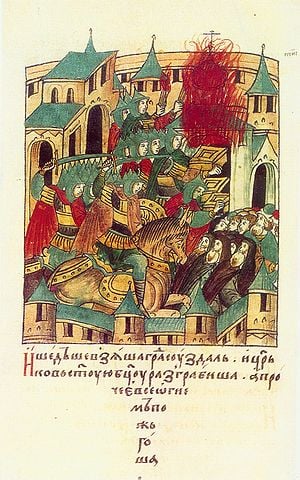
The invading Mongols accelerated the fragmentation of the Ancient Rus'. In 1223, the disunited southern princes faced a Mongol raiding party at the Kalka River and were soundly defeated. In 1237-1238 the Mongols burnt down the city of Vladimir(February 4, 1238) and other major cities of northeast Russia, routed the Russians at the Sit' River, and then moved west into Poland and Hungary. By then they had conquered most of the Russian principalities. Only the Novgorod Republic escaped occupation and continued to flourish in the orbit of the Hanseatic League.
The impact of the Mongol invasion on the territories of Kievan Rus' was uneven. The advanced city culture was almost completely destroyed. As older centers such as Kiev and Vladimir never recovered from the devastation of the initial attack,[2] the new cities of Moscow, began to compete for hegemony in the Mongol-dominated Russia. Although a Russian army defeated the Golden Horde at Kulikovo in 1380, Tatar domination of the Russian-inhabited territories, along with demands of tribute from Russian princes, continued until about 1480.
Russo-Tatar relations
After the fall of the Khazars in the tenth century, the middle Volga came to be dominated by the mercantile state of Volga Bulgaria, the last vestige of Greater Bulgaria centered at Phanagoria. In the tenth century, the Turkic population of Volga Bulgaria converted to Islam, which facilitated its trade with the Middle East and Central Asia. In the wake of the Mongol invasions of the 1230s, Volga Bulgaria was absorbed by the Golden Horde and its population evolved into the modern Chuvashes and Kazan Tatars.
The Mongols held Russia and Volga Bulgaria in sway from their western capital at Sarai, one of the largest cities of the medieval world. The princes of southern and eastern Russia had to pay tribute to the Mongols of the Golden Horde, commonly called Tatars; but in return they received charters authorizing them to act as deputies to the khans. In general, the princes were allowed considerable freedom to rule as they wished, while the Russian Orthodox Church even experienced a spiritual revival under the guidance of Metropolitan Alexis and Sergius of Radonezh.
To the Orthodox Church and most princes, the fanatical Northern Crusaders seemed a greater threat to the Russian way of life than the Mongols. In the mid-thirteenth century, Alexander Nevsky, elected prince of Novgorod, acquired heroic status as the result of major victories over the Teutonic Knights and the Swedes. Alexander obtained Mongol protection and assistance in fighting invaders from the west who, hoping to profit from the Russian collapse since the Mongol invasions, tried to grab territory and convert the Russians into Roman Catholicism.
The Mongols left their impact on the Russians in such areas as military tactics and transportation. Under Mongol occupation, Russia also developed its postal road network, census, fiscal system, and military organization. Eastern influence remained strong well until the seventeenth century, when Russian rulers made a conscious effort to Westernize their country.
The rise of Moscow
Daniil Aleksandrovich, the youngest son of Alexander Nevsky, founded the principality of Moscow (known in the western tradition as Muscovy), which eventually expelled the Tatars from Russia. Well-situated in the central river system of Russia and surrounded by protective forests and marshes, Moscow was at first only a vassal of Vladimir, but soon it absorbed its parent state. A major factor in the ascendancy of Moscow was the cooperation of its rulers with the Mongol overlords, who granted them the title of Grand Prince of Moscow and made them agents for collecting the Tatar tribute from the Russian principalities. The principality's prestige was further enhanced when it became the center of the Russian Orthodox Church. Its head, the metropolitan, fled from Kiev to Vladimir in 1299 and a few years later established the permanent headquarters of the Church in Moscow.
By the middle of the fourteenth century, the power of the Mongols was declining, and the Grand Princes felt able to openly oppose the Mongol yoke. In 1380, at Kulikovo on the Don River, the Mongols were defeated, and although this hard-fought victory did not end Tatar rule of Russia, it did bring great fame to the Grand Prince. Moscow's leadership in Russia was now firmly based and by the middle of the fourteenth century its territory had greatly expanded through purchase, war, and marriage.
Ivan III, the Great
In the fifteenth century, the grand princes of Moscow went on gathering Russian lands to increase the population and wealth under their rule. The most successful practitioner of this process was Ivan III, the Great (1462–1505), who laid the foundations for a Russian national state. Ivan competed with his powerful northwestern rival, the Grand Duchy of Lithuania, for control over some of the semi-independent Upper Principalities in the upper Dnieper and Oka River basins.
Through the defections of some princes, border skirmishes, and a long war with the Novgorod Republic, Ivan III was able to annex Novgorod and Tver. As a result, the Grand Duchy of Moscow tripled in size under his rule. During his conflict with Pskov, a monk named Filofei (Philotheus of Pskov) composed a letter to Ivan III, with the prophecy that the latter's kingdom will be the Third Rome. The Fall of Constantinople and the death of the last Greek Orthodox Christian emperor contributed to this new idea of Moscow as 'New Rome' and the seat of Orthodox Christianity.
A contemporary of the Tudors and other "new monarchs" in Western Europe, Ivan proclaimed his absolute sovereignty over all Russian princes and nobles. Refusing further tribute to the Tatars, Ivan initiated a series of attacks that opened the way for the complete defeat of the declining Golden Horde, now divided into several khanates and hordes. Ivan and his successors sought to protect the southern boundaries of their domain against attacks of the Crimean Tatars and other hordes. To achieve this aim, they sponsored the construction of the Great Abatis Belt and granted manors to nobles, who were obliged to serve in the military. The manor system provided a basis for an emerging horse army.
In this way, internal consolidation accompanied outward expansion of the state. By the sixteenth century, the rulers of Moscow considered the entire Russian territory their collective property. Various semi-independent princes still claimed specific territories, but Ivan III forced the lesser princes to acknowledge the grand prince of Moscow and his descendants as unquestioned rulers with control over military, judicial, and foreign affairs. Gradually, the Russian ruler emerged as a powerful, autocratic ruler, a tsar. The first Russian ruler to officially crown himself "Tsar" was Ivan IV.
Ivan IV, the Terrible
The development of the Tsar's autocratic powers reached a peak during the reign (1547–1584) of Ivan IV ("Ivan the Terrible"). He strengthened the position of the monarch to an unprecedented degree, as he ruthlessly subordinated the nobles to his will, exiling or executing many on the slightest provocation. Nevertheless, Ivan is often seen a farsighted statesman who reformed Russia as he promulgated a new code of laws (Sudebnik of 1550), established the first Russian feudal representative body (Zemsky Sobor), curbed the influence of clergy, and introduced the local self-management in rural regions.
Although his long Livonian War for the control of the Baltic coast and the access to sea trade ultimately proved a costly failure, Ivan managed to annex the Khanates of Kazan, Astrakhan, and Siberia. These conquests complicated the migration of the aggressive nomadic hordes from Asia to Europe through Volga and Ural. Through these conquests, Russia acquired a significant Muslim Tatar population and emerged as a multiethnic and multiconfessional state. Also around this period, the mercantile Stroganov family established a firm foothold at the Urals and recruited Russian Cossacks to colonize Siberia.
In the later part of his reign, Ivan divided his realm in two. In the zone known as the oprichnina, Ivan's followers carried out a series of bloody purges of the feudal aristocracy (which he suspected of treachery after the betrayal of prince Kurbsky), culminating in the Massacre of Novgorod (1570). This combined with the military losses, epidemics, poor harvests so weakened Muscovy that the Crimean Tatars were able to sack central Russian regions and burn down Moscow (1571).
At the end of Ivan IV's reign the Polish-Lithuanian and Swedish armies carried out the powerful intervention into Russia, devastated its northern and northwest regions.
Time of Troubles
The death of Ivan's childless son Feodor was followed by a period of civil wars and foreign intervention known as the "Time of Troubles" (1606–13). Extremely cold summer (1601-1603) wrecked crops, that led to the famine and increased the social disorganization. Boris Godunov's reign ended in chaos, civil war combined with foreign intrusion, devastation of many cities and depopulation of the rural regions. The country rocked by internal chaos also attracted several waves of interventions by Polish-Lithuanian Commonwealth. The invaders reached Moscow and installed, first, the impostor False Dmitriy I and, later, a Polish prince Władysław IV Vasa on the Russian throne. Moscow population revolted but the riots were brutally suppressed and the city was set on fire.
The crisis provoked the patriotic national uprising against the invasion and in the Autumn, 1612 the volunteer army led my the merchant Kuzma Minin and prince Dmitry Pozharsky, expelled the foreign forces from the capital.
The Russian statehood survived the "Time of Troubles" and the rule of weak or corrupt Tsars because of the strength of the government's central bureaucracy. Government functionaries continued to serve, regardless of the ruler's legitimacy or the faction controlling the throne.
Early Romanovs
In February, 1613, with the chaos ended and the Poles expelled from Moscow, a national assembly, composed of representatives from 50 cities and even some peasants, elected Michael Romanov, the young son of Patriarch Filaret, to the throne. The Romanov dynasty ruled Russia until 1917.
The immediate task of the new dynasty was to restore peace. Fortunately for Moscow, its major enemies, the Polish-Lithuanian Commonwealth and Sweden, were engaged in a bitter conflict with each other, which provided Russia the opportunity to make peace with Sweden in 1617 and to sign a truce with the Polish-Lithuanian Commonwealth in 1619. Recovery of lost territories started in the mid-seventeenth century, when the Khmelnitsky Uprising in Ukraine against the
Polish rule brought about the Treaty of Pereyaslav concluded between Russia and the Ukrainian Cossacks. According to the treaty, Russia granted protection to the Cossacks state in the Left-bank Ukraine, formerly under the Polish control. This triggered a prolonged Russo-Polish War which ended with the Treaty of Andrusovo (1667) were Poland accepted the loss of Left-bank Ukraine, Kiev and Smolensk.
Rather than risk their estates in more civil war, the great nobles or boyars cooperated with the first Romanovs, enabling them to finish the work of bureaucratic centralization. Thus, the state required service from both the old and the new nobility, primarily in the military. In return the tsars allowed the boyars to complete the process of enserfing the peasants.
Peasants rebel
In the preceding century, the state had gradually curtailed peasants' rights to move from one landlord to another. With the state now fully sanctioning serfdom, runaway peasants became state fugitives, and the power of the landlords over the peasants "attached" to their land have become almost complete. Together the state and the nobles placed the overwhelming burden of taxation on the peasants, whose rate was 100 times greater in the mid-seventeenth century than it had been a century earlier. In addition, middle-class urban tradesmen and craftsmen were assessed taxes, and, like the serfs, they were forbidden to change residence. All segments of the population were subject to military levy and to special taxes.
Under such circumstances, peasant disorders were endemic; even the citizens of Moscow revolted against the Romanovs during the Salt Riot (1648), Copper Riot (1662), and the Moscow Uprising (1682). By far the greatest peasant uprising in seventeenth century Europe erupted in 1667. As the free settlers of South Russia, the Cossacks, reacted against the growing centralization of the state, serfs escaped from their landlords and joined the rebels. The Cossack leader Stenka Razin led his followers up the Volga River, inciting peasant uprisings and replacing local governments with Cossack rule. The tsar's army finally crushed his forces in 1670; a year later Stenka was captured and beheaded. Yet, less than half a century later, the strains of military expeditions produced another revolt in Astrakhan, ultimately subdued.
Peter the Great
Peter I, the Great (1672–1725), consolidated autocracy in Russia and played a major role in bringing his country into the European state system. From its modest beginnings in the fourteenth century principality of Moscow, Russia had become the largest state in the world by Peter's time. Three times the size of continental Europe, it spanned the Eurasian landmass from the Baltic Sea to the Pacific Ocean. Much of its expansion had taken place in the seventeenth century, culminating in the first Russian settlement of the Pacific in the mid-seventeenth century, the reconquest of Kiev, and the pacification of the Siberian tribes. However, this vast land had a population of only 14 million. Grain yields trailed behind those of agriculture in the West (that can be partly explained by the heavier climatic conditions, in particular long cold winters and short vegetative period compelling almost the entire population to farm. Only a small fraction of the population lived in the towns. Russia remained isolated from the sea trade, its internal trade communications and many manufactures were dependent on the seasonal changes.
Peter's first military efforts were directed against the Ottoman Turks.His aim was to establish a Russian foothold on the Black Sea by taking the town of Azov. His attention then turned to the north. Peter still lacked a secure northern seaport except at Archangel on the White Sea, whose harbor was frozen nine months a year. Access to the Baltic was blocked by Sweden, whose territory enclosed it on three sides. Peter's ambitions for a "window to the sea" led him in 1699 to make a secret alliance with the Polish-Lithuanian Commonwealth and Denmark against Sweden resulting in the Great Northern War. The war ended in 1721 when an exhausted Sweden sued for peace with Russia. Peter acquired four provinces situated south and east of the Gulf of Finland, thus securing his coveted access to the sea. There, in 1703, he had already founded the city that was to become Russia's new capital, St. Petersburg, as a "window opened upon Europe" to replace Moscow, long Russia's cultural center. Russian intervention in the Commonwealth marked, with the Silent Sejm, beginning of 200-year domination of that region by the Russian Empire. In celebration of his conquests, Peter assumed the title of emperor as well as tsar, and Muscovite Russia officially became the Russian Empire in 1721.
Peter reorganized his government on the latest Western models, molding Russia into an absolutist state. He replaced the old boyar Duma (council of nobles) with a nine-member senate, in effect a supreme council of state. The countryside was also divided into new provinces and districts. Peter told the senate that its mission was to collect tax revenues. In turn tax revenues tripled over the course of his reign. As part of the government reform, the Orthodox Church was partially incorporated into the country's administrative structure, in effect making it a tool of the state. Peter abolished the patriarchate and replaced it with a collective body, the Holy Synod, led by a lay government official. Meanwhile, all vestiges of local self-government were removed, and Peter continued and intensified his predecessors' requirement of state service for all nobles.
Peter died in 1725, leaving an unsettled succession and an exhausted realm. His reign raised questions about Russia's backwardness, its relationship to the West, the appropriateness of reform from above, and other fundamental problems that have confronted many of Russia's subsequent rulers. Nevertheless, he had laid the foundations of a modern state in Russia.
Catherine the Great
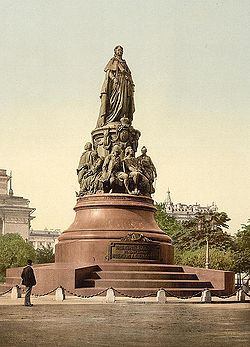
Nearly forty years were to pass before a comparably ambitious and ruthless ruler appeared on the Russian throne. Catherine II, the Great, was a German princess who married the German heir to the Russian crown. Finding him incompetent, Catherine tacitly consented to his murder. It was announced that he had died of "apoplexy", and in 1762 she became ruler.
Catherine contributed to the resurgence of the Russian nobility that began after the death of Peter the Great. Mandatory state service had been abolished, and Catherine delighted the nobles further by turning over most government functions in the provinces to them.
Catherine the Great extended Russian political control over the Polish-Lithuanian Commonwealth with actions including the support of the Targowica Confederation, although the cost of her campaigns, on top of the oppressive social system that required lords' serfs to spend almost all of their time laboring on the lords' land, provoked a major peasant uprising in 1773, after Catherine legalized the selling of serfs separate from land. Inspired by another Cossack named Pugachev, with the emphatic cry of "Hang all the landlords!" the rebels threatened to take Moscow before they were ruthlessly suppressed. Catherine had Pugachev drawn and quartered in Red Square, but the specter of revolution continued to haunt her and her successors.
Catherine successfully waged war against the decaying Ottoman Empire and advanced Russia's southern boundary to the Black Sea. Then, by allying with the rulers of Austria and Prussia, she incorporated the territories of the Polish-Lithuanian Commonwealth, where after a century of Russian rule non-Catholic mainly Orthodox population prevailed during the Partitions of Poland, pushing the Russian frontier westward into Central Europe. By the time of her death in 1796, Catherine's expansionist policy had made Russia into a major European power. This continued with Alexander I's wresting of Finland from the weakened kingdom of Sweden in 1809 and of Bessarabia from the Ottomans in 1812.
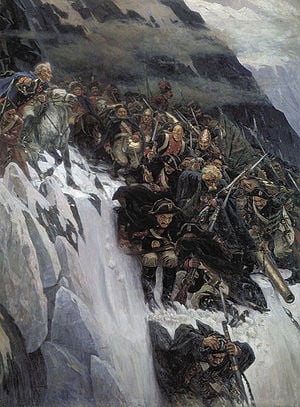
Napoleon made a major misstep when he declared war on Russia after a dispute with Tsar Alexander I and launched an invasion of Russia in 1812. The campaign was a catastrophe. In the bitterly cold Russian weather, thousands of French troops were ambushed and killed by peasant guerrilla fighters. As Napoleon's forces retreated, the Russian troops pursued them into Central and Western Europe and to the gates of Paris. After Russia and its allies defeated Napoleon, Alexander became known as the 'savior of Europe,' and he presided over the redrawing of the map of Europe at the Congress of Vienna (1815), which made Alexander the monarch of Congress Poland.
Although the Russian Empire would play a leading political role in the next century, secured by its defeat of Napoleonic France, its retention of serfdom precluded economic progress of any significant degree. As West European economic growth accelerated during the Industrial Revolution, sea trade and exploitation of colonies which had begun in the second half of the eighteenth century, Russia began to lag ever farther behind, creating new problems for the empire as a great power.
xxxx The perseverance of Russian serfdom and the conservative policies of Nicholas I of Russia impeded the development of Imperial Russia in the mid-nineteenth century. As a result, the country was defeated in the Crimean War, 1853–1856, by an alliance of major European powers, including Britain, France, Ottoman Empire, and Piedmont-Sardinia. Nicholas's successor Alexander II (1855–1881) was forced to undertake a series of comprehensive reforms and issued a decree abolishing serfdom in 1861. The Great Reforms of Alexander's reign spurred increasingly rapid capitalist development and Sergei Witte's attempts at industrialisation. The Slavophile mood was on the rise, spearheaded by Russia's victory in the Russo-Turkish War, which forced the Ottoman Empire to recognise the independence of Romania, Serbia and Montenegro and autonomy of Bulgaria.
The failure of agrarian reforms and suppression of the growing liberal intelligentsia were continuing problems however, and on the eve of World War I, the position of Tsar Nicholas II and his dynasty appeared precarious. The Russian government did not want war in 1914 but felt that the only alternative was acceptance of German domination of Europe.[3] Upper- and middle-class Russians rallied around the regime’s war effort.[3] Peasants and workers were much less enthusiastic.[3] Germany was Europe’s leading military and industrial power, and Austria and the Ottoman Empire were its allies in the war.[3] Consequently, Russia was forced to fight on three fronts and was isolated from its French and British war partners.[3] Under these circumstances the Russian war effort was impressive.[3] Having won a number of major battles in 1916, the army was far from defeated when the Russian Revolution of 1917 broke out in February.[3] The home front collapsed under the strains of war, partly for economic reasons but primarily because the already existing public distrust of the regime was deepened by tales of inefficiency, corruption, and even treason in high places.[3] Many of these tales were nonsense or grossly exaggerated, such as the belief that a semiliterate mystic, Grigory Rasputin, had great political influence within the government.[3] What mattered, however, was that the rumors were believed.[3] At the close of the Russian Revolution of 1917, a Marxist political faction called the Bolsheviks seized power in Petrograd and Moscow under the leadership of Vladimir Lenin. The Bolsheviks changed their name to the Communist Party. A bloody civil war ensued, pitting the Bolsheviks' Red Army against a loose confederation of anti-socialist monarchist and bourgeois forces known as the White Army. The Treaty of Brest-Litovsk, a peace treaty signed by the Central Powers with Soviet Russia, concluded hostilities between those countries in World War I. Russia lost the Ukraine, its Polish and Baltic territories, and Finland by signing the treaty, which was later annulled by the Armistice. Following the defeat of the Central Powers and the Armistice treaty, these states became independent, but were later incorporated into the Soviet Union, which effectively covered the same territory that Russia did before the Treaty of Brest-Litovsk. The Red Army triumphed in the Civil War, and the Soviet Union was formed in 1922.
Soviet Russia
After a failed Bolshevik rising in July 1917, Lenin fled to Finland for safety. Here he wrote "State and Revolution",[4] which called for a new form of government based on workers' councils, or soviets elected and revocable at all moments by the workers. He returned to Petrograd in October, inspiring the October Revolution with the slogan "All Power to the Soviets!". Lenin directed the overthrow of the Provisional Government from the Smolny Institute from the 6th to the 8th of November 1917. The storming and capitulation of the Winter Palace on the night of the 7th to 8th of November marked the beginning of Soviet rule. On November 8, 1917, Lenin was elected as the Chairman of the Council of People's Commissars by the Russian Congress of Soviets. Lenin emphasised the importance of bringing electricity to all corners of Russia and modernising industry and agriculture. He was very concerned about creating a free universal health care system for all, the rights of women, and teaching all Russian people to read and write.[5] On December 301922, the Russian SFSR together with three other Soviet republics formed the Soviet Union.[6]
The Soviet Union was meant to be a trans-national worker's state free from nationalism.[citation needed] The concept of Russia as a separate national entity was therefore not emphasised in the early Soviet Union.[citation needed] However, people and leaders around the world often referred to the Soviet Union as "Russia" and its people as "Russians". The Russian Soviet Federated Socialist Republic dominated the Soviet Union for its entire 74-year history.[7] The Russian Federation was by far the largest of the republics; Moscow, its capital, was also the capital of the Soviet Union.[7] Although Russian institutions and cities certainly remained dominant, non-Russians participated in the new government at all levels. After Lenin's death in 1924, a brief power struggle ensued, during which a top communist official, a Georgian named Joseph Stalin, gradually eroded the various checks and balances which had been designed into the Soviet political system and assumed dictatorial power by the end of the decade.[6]
1927-1953
Stalin forced rapid industrialisation of the largely rural country and collectivisation of its agriculture. In 1928, Stalin introduced his First Five Year Plan for modernising the Soviet economy.[8] Most economic output was immediately diverted to establishing heavy industry. Civilian industry was modernised and many heavy weapon factories were established. The plan worked, in some sense, as the Soviet Union successfully transformed from an agrarian economy to a major industrial powerhouse in an unbelievably short span of time, but widespread misery and famine ensued for many millions of people as a result of the severe economic upheaval.
Almost all Old Bolsheviks from the time of the Revolution, including Leon Trotsky, were killed or exiled. At the end of 1930s, Stalin launched the Great Purges, a massive series of political repressions. Millions of people whom Stalin and local authorities suspected of being a threat to their power were executed or exiled to Gulag labor camps in remote areas of Siberia or Central Asia. A number of ethnic groups in Russia and other republics were also forcibly resettled during Stalin's rule.
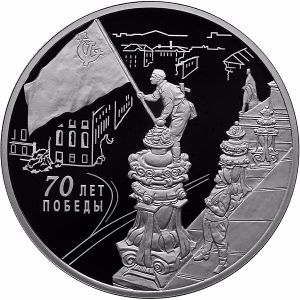

The defensive war of the Soviet Union against Nazi Germany, part of the World War II known in the Soviet Union and Russia as the Great Patriotic War, started with the German invasion of the Soviet Union on June 221941. It was the largest theatre of war in history and was notorious for its unprecedented ferocity, destruction, and immense loss of life. The fighting involved millions of German and Soviet troops along a broad front. It was by far the deadliest single theatre of war in World War II, with over 5.5 million deaths on the Axis Forces; Soviet military deaths were about 8.6 million (out of which 2.8 - 3.3 million Soviet prisoners of war (of 5.5 million) died in German captivity),[9][10][11] and civilian deaths were about 14 to 18 million. The Eastern Front contained more combat than all the other European fronts combined; the German army suffered 80% to 93% of all casualties there.[12][13] The fate of the Third Reich was decided at Stalingrad and sealed at Kursk. The German army had considerable success in the early stages of the campaign, but they suffered defeat when they reached the outskirts of Moscow. The Red Army then stopped the Nazi offensive at the Battle of Stalingrad in the winter of 1942-43, which became the decisive turning point for Germany's fortunes in the war. The Soviets drove through Eastern Europe and captured Berlin before Germany surrendered in 1945. During the war, the Soviet Union lost around 27 million citizens [14][15] (including up to 18 million civilians), about half of all World War II casualties.
Although ravaged by the war, the Soviet Union emerged from the conflict as an acknowledged superpower. The Red Army occupied Eastern Europe after the war, including the eastern half of Germany. Stalin installed loyal communist governments in these satellite states. During the immediate postwar period, the Soviet Union first rebuilt and then expanded its economy, with control always exerted exclusively from Moscow. The Soviets extracted heavy war reparations from the areas of Germany under their control, mostly in the form of machinery and industrial equipment. The Soviet Union consolidated its hold on Eastern Europe (see Eastern bloc) and entered a long struggle with the United States and Western Europe on economic, political, and ideological dominance over the Third World. The ensuing struggle became known as the Cold War, which turned the Soviet Union's wartime allies, Britain and the United States, into its foes.
1953-1985
Under Khrushchev, the Soviet Union launched the world's first artificial satellite, Sputnik 1, and the Soviet cosmonaut Yuri Gagarin became the first human to orbit the Earth aboard the first manned spacecraft, Vostok 1. The space race produced rapid advances in rocketry, material science, computers, and many other areas. Khrushchev's reforms in agriculture and administration, however, were generally unproductive. Foreign policy toward China and the United States suffered reverses, notably the Cuban Missile Crisis, when Khrushchev began installing nuclear missiles in Cuba (after the United States installed Jupiter missiles in Turkey, which nearly provoked a war with the Soviet Union). Following the ousting of Khrushchev, another period of rule by collective leadership ensued until Leonid Brezhnev established himself in the early 1970s as the pre-eminent figure in Soviet politics. Brezhnev is frequently derided by historians for stagnating the development of the Soviet Union (see "Brezhnev stagnation"). Others have acknowledged that despite its inertia and repression (though very mild relative to the Stalin years), the Brezhnev era did offer a relative prosperity to a populace and leadership battered by decades of war, famine, collectivisation and crash industrialisation, deadly political crises, arbitrary mass murder and arrest, and the volatility of the Khrushchev years. In 1979 the troubled nine-year Soviet war in Afghanistan began.
1985-1991
Following the short rules of Yury Andropov and Konstantin Chernenko, in 1985, the reform-minded[16] Mikhail Gorbachev came to power. He introduced the landmark policies of glasnost (openness) and perestroika (restructuring), in an attempt to modernise Soviet communism. Glasnost meant that the harsh restrictions on free speech that had characterised most of the Soviet Union's existence were alleviated, and open political discourse and criticism of the government became possible again. Perestroika meant sweeping economic reforms designed to decentralise the planning of the Soviet economy. However, the Stalinist system was probably beyond repair, and the Gorbachev reforms started in motion forces of change that demonstrated that meaningful reform would eventually threaten Communist Party hegemony. His initiatives also provoked strong resentment amongst conservative elements of the government, and in August of 1991 an unsuccessful military coup that attempted to remove Gorbachev from power instead led to the collapse of the Soviet Union. Boris Yeltsin came to power and declared the end of exclusive Communist rule. The USSR splintered into fifteen independent republics, and was officially dissolved in December of 1991. Prior to the dissolution of the Soviet Union, Boris Yeltsin had been elected President of Russia in June 1991 in the first direct presidential election in Russian history. In October 1991, as Russia was on the verge of independence, Yeltsin announced that Russia would proceed with radical market-oriented reform along the lines of "shock therapy".[17]
Post-Soviet Russia
After the disintegration of the USSR, the Russian economy went through a crisis.[18] Russia took up the responsibility for settling the USSR's external debts, even though its population made up just half of the population of the USSR at the time of its dissolution.[19] The largest state enterprises (petroleum, metallurgy, and the like) were controversially privatised by President Boris Yeltsin to insiders[20] (who became billionaires virtually overnight) for far less than they were worth, while the majority of the population plunged into poverty.[17] Corruption has run rampant,[21] and the Yeltsin government has been accused of conspiring with insiders to loot countless billions in cash and assets from the State[22] (for example, Yeltsin's son-in-law became the CEO of Aeroflot, Russia's largest airline).
The 1990s were plagued by armed ethnic conflicts in the North Caucasus.[17] Such conflicts took a form of separatist Islamist insurrections against federal power (most notably in Chechnya), or of ethnic/clan conflicts between local groups (e.g., in North Ossetia-Alania between Ossetians and Ingushs, or between different clans in Chechnya).[17] Since the Chechen separatists declared independence in the early 1990s, an intermittent guerrilla war (First Chechen War, Second Chechen War) has been fought between disparate Chechen groups and the Russian military.[17] Russia has severely disabled the Chechen rebel movement, although sporadic violence still occurs throughout the North Caucasus.[24]
After Yeltsin's presidency in the 1990s, the recently appointed Prime Minister (who was also head of the FSB from July 1998 through August 1999) Vladimir Putin was elected in 2000. High oil prices and growing internal demand boosted Russian economic growth, stimulating significant economic expansion abroad and helping to finance increased military spending.[17] Putin's presidency has shown improvements in the Russian standard of living, as opposed to the 1990s.[17][25] Under Putin, the economy developed significantly and currently Russia enjoys a state of rapid economical growth, averaging 6.7% annual GDP growth for the past 8 straight years.[24]
Government and politics
The politics of the Russian Federation take place in a framework of a federal presidential republic.According to the Constitution of Russia, the president is head of state, and of a pluriform multi-party system with executive power exercised by the government, headed by the prime minister, who is appointed by the president by the parliament's approbation. Legislative power is vested in the two chambers of the federal assembly, while the president and the government issue numerous legally binding by-laws. Although Russia has traditionally been ruled by absolute monarchs and dictators, in 2007 it had a democratic system of government.
Structure
For the executive, the president is elected by popular vote for a four-year term and is eligible for a second term. An election was last held in March 2004. Vladimir Putin has been acting president since December 1999, and president since May 2000. The president appoints a cabinet comprising the premier and his deputies, ministers, and selected other individuals.
The legislature, termed the Federal Assembly or Federalnoye Sobraniye, consists of two chambers, the 450-member State Duma or Gosudarstvennaya Duma and the 178-member Federation Council or Sovet Federatsii.
Duma members are put forward from party lists on a basis of proportional representation. A party gains representation by winning at least five percent of the vote to serve four-year terms. There are 225 party list seats, and 225 seats representing electorates. Duma elections were last held in December 2003. Sobraniye members are appointed by the top executive and legislative officials in each of the 88 federal administrative units - oblasts, krays, republics, autonomous okrugs and oblasts, and the federal cities of Moscow and Saint Petersburg, to serve four-year terms. United Russia won 37.1 percent of the vote in 2003, CPRF 12.7 percent, LDPR 11.6 percent,, Motherland 9.1 percent, and other 29.5 percent.
The Russian judiciary is divided into three branches: The courts of general jurisdiction (including military courts); subordinated to the Supreme Court; the arbitration (commercial) court system under the High Court of Arbitration; and the Constitutional Court (as well as constitutional courts in a number of administrative entities of the Russian Federation). Civil and criminal cases are tried in courts of primary jurisdiction, courts of appeals, and higher courts. The general court system's lowest level is the municipal court, which serves each city or rural district and hears more than 90% of all civil and criminal cases. The next level of courts of general jurisdiction is the regional courts. At the highest level is the Supreme Court. Judges for all courts are appointed for life by the Federation Council on the recommendation of the president.
The legal system is based on civil law system, there is judicial review of legislative acts, and the Russian Federation has not accepted compulsory ICJ jurisdiction. Constitutional justice is based on the equality of all citizens. Judges are independent and subject to the law. Trials are to be open, and the accused is guaranteed a defense.
Constitutional challenges
Since gaining its independence with the collapse of the Soviet Union at the end of 1991, Russia has faced serious challenges in its efforts to forge a political system to follow nearly 75 years of Soviet rule. For instance, leading figures in the legislative and executive branches have put forth opposing views of Russia's political direction and the governmental instruments that should be used to follow it. That conflict reached a climax in September and October 1993, when President Boris Yeltsin used military force to dissolve the parliament and called for new legislative elections. This event marked the end of Russia's first constitutional period, which was defined by the much-amended constitution adopted by the Russian Republic in 1978. |A new constitution, creating a strong presidency, was approved by referendum in December 1993.
With a new constitution and a new parliament representing diverse parties and factions, Russia's political structure subsequently showed signs of stabilization. As the transition period extended into the mid-1990s, the power of the national government continued to wane as Russia's regions gained political and economic concessions from Moscow. Although the struggle between executive and legislative branches was partially resolved by the new constitution, the two branches continued to represent fundamentally opposing visions of Russia's future. Most of the time, the executive was the center of reform, and the lower house of the parliament, the State Duma, was a bastion of antireform communists and nationalists.
Foreign relations
The Russian Federation (Russia) is recognised in international law as continuing the legal personality of the former Soviet Union. The Russian Federation continues to implement the international commitments of the USSR, and has assumed the USSR's permanent seat on the UN Security Council, membership in other international organisations, the rights and obligations under international treaties and property and debts. Russia is one of the key players in international relations. As one of five permanent members of the UN Security Council, Russia has a special responsibility for maintaining international peace and security.
Russia is the leading nation of the Commonwealth of Independent States.
Since 1994, Russia has participated as a member of the Group of Eight (G8) industrialised nations, although the Finance Ministers/Secretaries of Finance and Leaders of the G7 central banks continue to meet several times a year, without their Russian counterparts. Russia is a member of the Council of Europe and OSCE. Russia takes a special role in the organisations created on the territory of the former USSR, largely under the leadership of Russia : CIS, EurAsEC, CSTO, SCO.
The collapse of the Soviet Union has also resulted in Russia becoming a somewhat more NATO-friendly country and the establishment of the NATO-Russia Council, which brings together the NATO members and the Russian Federation; however, Russia has not formally joined the NATO as an ally, nor has Russia expressed any desire to join NATO.
Russia has a multifaceted foreign policy. It maintains diplomatic relations with 178 countries and has 140 embassies. Russia's foreign policy is determined by the President and implemented by the Ministry of Foreign Affairs.
Subdivisions
The Russian Federation comprises 85 federal subjects, namely:
- 47 oblasts (provinces)
- 21 republics (states) which enjoy a high degree of autonomy on most issues and which correspond to some of Russia's numerous ethnic minorities
- eight krais (territories)
- six okrugs (autonomous districts)
- two federal cities (Moscow and St. Petersburg)
- the Jewish Autonomous Oblast.
Federal subjects are grouped into seven federal districts, each administered by an envoy appointed by the President of Russia. Unlike the federal subjects, the federal districts are not a sub-national level of government, but are a level of administration of the federal government. Federal districts' envoys serve as liaisons between the federal subjects and the federal government and are primarily responsible for overseeing the compliance of the federal subjects with the federal laws.
For economic and statistical purposes the federal subjects are grouped into 12 economic regions. Economic regions and their parts sharing common economic trends are in turn grouped into economic zones and macrozones.
Military
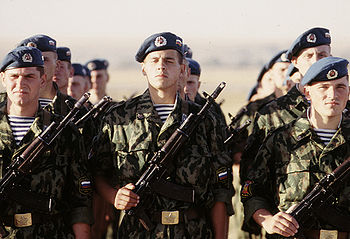
After the dissolution of the USSR, in 1991, Russia assumed control of Soviet assets abroad, and received the lion's share of the Soviet Union's production facilities and military forces. About 70 percent of the former Soviet Union's defense industries are located in the Russian Federation.
The Russian military is divided into the Ground Forces, Navy, and Air Force. There are also three independent arms of service: Strategic Rocket Forces, Military Space Forces, and the Airborne Troops. Russia ranks at or near the top of many metrics of military power including in numbers of tanks, fighter aircraft and naval vessels; it has the largest stockpile of nuclear weapons. It also has the second largest fleet of ballistic missile submarines, and is the only country apart from the U.S. with a modern strategic bomber force. As of 2005, 330,000 men are brought into the army via conscription annually, though the Army in 2007 was phasing out conscription altogether.
Defence spending is consistently increasing by at least a minimum of one-third year on year, leading to overall defence expenditure almost quadrupling over the past six years, and according to Finance Minister Alexei Kudrin, this rate is to be sustained through 2010.Official government military spending for 2007 was $32.4 billion, though various sources, including the US Department of Defense, have estimated Russia’s military expenditures to be considerably higher than the reported amount. By some estimates, overall Russian defence expenditure is now at the second highest in the world after the USA. The recent steps towards modernisation of the Armed Forces has been made possible by Russia's spectacular economic resurgence based on oil and gas revenues as well a strengthening of its own domestic market. Currently, the military is in the middle of a major equipment upgrade, with the government in the process of spending about $200-billion (what equals to about $400-billion in PPP dollars) on development and production of military equipment between 2006-2015. Russia is the world's top supplier of weapons, a spot it has held since 2001, accounting for around 30% of worldwide weapons sales. Russia is the principal weapons supplier of China and India, and provides weapons to Iran, Algeria, Venezuella and other countries. Recent arms deals seem to show that Russia is building on its former influence, both in the Middle East and in Latin America.
Economy
More than a decade after the collapse of the Soviet Union in 1991, Russia is trying to further develop a market economy and achieve much more consistent economic growth. Russia saw its comparatively developed centrally planned economy contract severely for five years, as the executive and the legislature dithered over the implementation of reforms and Russia's aging industrial base faced a serious decline.[26] However, Russia's economy has adapted relatively quickly from the world's largest centrally planned economy to a market economy. Russia ended 2006 with its eighth straight year of growth, averaging 6.7% annually since the financial crisis of 1998. Although high oil prices and a relatively cheap ruble initially drove this growth, since 2003 consumer demand and, more recently, investment have played a significant role.[24] Over the last five years, fixed capital investments have averaged real gains greater than 10% per year and personal incomes have achieved real gains more than 12% per year.[24] During this time, poverty has declined steadily and the middle class has continued to expand.[24] Russia has also improved its international financial position since the 1998 financial crisis.[24] The federal budget has run surpluses since 2001 and ended 2006 with a surplus of 9% of GDP.[24] Over the past several years, Russia has used its stabilization fund based on oil taxes to prepay all Soviet-era sovereign debt to Paris Club creditors and the IMF.[24] Oil export earnings have allowed Russia to increase its foreign reserves from $12 billion in 1999 to some $315 billion at yearend 2006, the third largest reserves in the world (currently it stands at $420.2 billion)[27].[24]
Russia's 2006 GDP was $1.723 trillion (est. PPP), the 9th highest in the world, with GDP growth of 6.8%. Growth was driven by non-tradable services and goods for the domestic market, as opposed to oil or mineral extraction and exports.[24] The Russian economy has once again outperformed expectations, and the International Monetary Fund forecasts that Russia's GDP will grow 7% in 2007.[28]
The economic development of the country has been extremely uneven geographically: the Moscow region contributes one-third of the country's GDP while having only a tenth of its population.[17] While the huge capital region of Moscow is an affluent metropolis, much of the country, especially indigenous and rural communities in Asia, lags significantly behind.
According to the Federal State Statistics Service of Russia, the monthly nominal average salary in January 2007 was 11,410 rubles (about $437 nominally; about $793 PPP), 26.6 percent higher than in January 2006.[29]
Russia's macroeconomic performance in recent years has been impressive. High oil prices and large capital inflows have contributed importantly to this success, but a principal factor has been the combination of strong growth in productivity, real wages, and consumption.[30] Very high levels of education and societal involvement achieved by the majority of the population, including women and minorities, secular attitudes, mobile class structure, and better integration of various minorities into the mainstream culture set Russia far apart from the majority of the so-called developing countries and even some developed nations.[17]
The country is also benefiting from rising oil prices and has been able to very substantially to reduce its formerly huge foreign debt.[31] However, equal redistribution of capital gains from the natural resource industries to other sectors is still a problem.[17] Nonetheless, since 2003, exports of natural resources started decreasing in economic importance as the internal market has strengthened considerably, largely stimulated by intense construction, as well as consumption of increasingly diverse goods and services.[17]
Knowing the importance of oil and gas to the economy, the Stabilization Fund of the Russian Federation was formed by the government in January 2004.[32] This fund takes in revenues from oil and gas exports and is designed to help offset oil market volatility.[32] Russia has the largest known natural gas reserves of any state on Earth, along with the second largest coal reserves, and the eighth largest oil reserves. It is the world's second largest oil producer.[33] Currently, its economy benefits greatly from the relatively high price of oil.
Demographics
Population
Though Russia's population is large, at 145,164,000 in 2006, its average population density is low because of its enormous size. Its population is densest in European Russia, near the Ural Mountains, and in the southwest Siberia. About 75 percent of the population live in urban areas. As of the 2002 Census, the two largest cities in Russia are Moscow (10,342,151 inhabitants) and Saint Petersburg (4,661,219). Eleven other cities had between one and two million inhabitants: Chelyabinsk, Kazan, Novosibirsk, Nizhny Novgorod, Omsk, Perm, Rostov-on-Don, Samara, Ufa, Volgograd, and Yekaterinburg.
Health
Russia's constitution guarantees free, universal health care for all Russian citizens. While Russia has more physicians, hospitals, and health care workers than almost any other country in the world, it has struggled to provide high levels of health care services. In the past decade, the health of the Russian population has declined considerably, a result of social, economic, and lifestyle changes. Life expectancy for the total population was 65.87 years in 2007 — 59.12 years for males, 73.03 years for females. The biggest factor contributing to this relatively low life expectancy is a high mortality rate among working-age males due to preventable causes (e.g., alcohol, smoking, traffic accidents, violent crimes). In 2006, the federal statistics agency reported that Russia's population shrunk by about 700,000 people, dipping to 142.8 million. The primary causes of Russia's population decrease are a high death rate and low birth rate. Heart disease claims proportionately more lives than in most of the rest of the world. Death rates from homicide, suicide, auto accidents and cancer are also especially high. Smoking also contributes to the demographic crisis, with more than 300,000 lives lost each year as a result of tobacco use.
In an effort to stem Russia’s demographic crisis, in 2006 the government doubled monthly child support payments and offered a one-time payment of US$9200 to women who had a second child. Russia is the second country in the world by the number of immigrants from abroad, mostly from the former Soviet Union, and immigration is increasingly seen as necessary to sustain the country's population.
Ethnicity
The Russian Federation is home to as many as 160 different ethnic groups and indigenous peoples. As of the 2002 Russian census, 79.8 percent of the population is ethnically Russian, 3.8 percent Tatar, 2 percent Ukrainian, 1.2 percent Bashkir, 1.1 percent Chuvash, 0.9 percent Chechen, 0.8 percent Armenian, and 10.3 percent other or unspecified. Nearly all groups besides Russians live compactly in their respective regions. Ethnic relations are stressed with tension resulting from centuries of Russian and Soviet domination and were activated by the collapse of the Soviet state. Conflicts center on political control, rights to natural resources, relocation of ethnic groups, and the revitalization of ethnic cultures, religions, languages, and identities. The Soviet regime compelled the use of the Russian language, forcibly relocated whole populations, installed ethnic Russian political elites in non-Russian regions, and drained regional resources.
Religion
Christianity, Islam, Buddhism, and Judaism are Russia’s traditional religions. Estimates of the number of believers range from 85-90 percent (all non-atheists) to 7-15 percent (all of the people who attend worship at least once a month). Estimates of believers widely fluctuate between sources, and some reports put the number of non-believers in Russia as high as 24-48 percent of the population. The ancestors of today’s Russians adopted Orthodox Christianity in the 10th century. The majority of Russian citizens, and as many as 80 percent of ethnic Russians, self-identify as Russian Orthodox. According to the Russian Public Opinion Research Center, 63 percent of respondents consider themselves Russian Orthodox. This makes the Russian Orthodox Church by far the most widespread religion. However, the vast majority of Orthodox believers do not attend church on a regular basis. The percentage of Russians who attend church services on a weekly basis was estimated by the Interior Ministry to be less than 2 percent. Nonetheless, the church is widely respected by both believers and nonbelievers, who see it as a symbol of Russian heritage and culture. Small numbers of other Christian demoninations exist. The number of Roman Catholics is estimated to be approximately 400,000 to 500,000; Armenian Gregorian, about 1.2 million; and Protestants, about 1 million.
Russia has from 10 to 20 million Muslims, constituting the largest religious minority. Most Muslims live in the Volga-Ural region, as well as in the North Caucasus, Moscow, St. Petersburg and western Siberia. In Russia there are more than 6000 mosques (in 1991 it was about 100). A particularly large number of Muslims live in rural areas, mainly in the Caucasus. According to the Federation of Jewish Communities of Russia, the number of Jews in Russia is about 1.5 million. Of these, according to the Federation of Jewish Communities of Russia, Moscow is home to some 500,000 Jews, and St. Petersburg about 170,000. In Russia there are about 70 synagogues.
Buddhism is traditional for three regions of the Russian Federation: Buryatia, Tuva and Kalmykia. According to the Buddhist Association of Russia, the number of people practising Buddhism is 1.5 to 2 million. Some residents of the Siberian and Far Eastern regions, Yakutia, Chukotka, etc., practice pantheistic and pagan rites, along with the major religions.
Induction into religion takes place primarily along ethnic lines. Ethnic Russians are mainly Orthodox whereas most people of Turkic extraction are Sunni Muslim. On the other hand, the New Age movement has led to emergence of some "non-traditional" religions in large cities. On May 17, 2007, an Act of Canonical Communion was signed between the Moscow Patriarchate of the Russian Orthodox Church and the Russian Orthodox Church Outside Russia.
Language
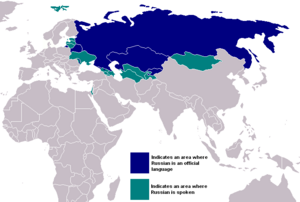
Russian is the only official state language, but the individual republics have often made their native language co-official next to Russian. The Cyrillic alphabet is the only official script, which means that these languages must be written in Cyrillic in official texts. Russian is the most geographically widespread language of Eurasia and the most widely spoken of the Slavic languages.
Russian belongs to the family of Indo-European languages and is one of three living members of the East Slavic languages; the others being Belarusian and Ukrainian (and possibly Rusyn, often considered a dialect of Ukrainian). The roots of the Russian language are some 3000 to 4000 years old. Written examples of Old East Slavonic are attested from the 10th century onwards.
While Russian preserves much of East Slavonic grammar and a Common Slavonic word base, modern Russian exhibits a large stock of borrowed international vocabulary for politics, science, and technology. Due to the status of the Soviet Union as a superpower, Russian had great political importance in the twentieth century. Hence, the language is still one of the official languages of the United Nations.
Men and women
Traditionally, newly married women were subservient in the families of their husbands until they had borne sons. Under communist ideology, which aimed to free women from oppressive norms, women were trained to take up men’s work, such as operating agricultural machinery, working in construction, and working on roads and railways. Nurseries and day care centers were set up to free women from child rearing. Soviet women gained authority and status in medicine and education, and increased political representation. But as unemployment grew in the 1990s, women were the first to lose their jobs. As a traditionalist view of work and family reappeared, some women whose husbands had succeeded in the new economy were glad to become full-time mums. Fewer women hold political office, and significant numbers of young women have been lured into prostitution.
Marriage and the family
Romantic love is considered the starting point of marriage, although more pragmatic motivations include improving economic status or housing prospects. People meet at school, university, at work, or at discos and clubs. Premarital sex is accepted, and cohabitation is tolerated, although 97 percent of adults marry by age 40. Every second marriage ends in divorce, resulting from economic hardship, or alcohol abuse. Ethnic intermarriage became common in the Soviet era.
Traditionally, the multigenerational extended family characterized peasant life until the twentieth century, and strict patriarchal control over the household was common to all social classes. The communist revolution sought to replace the traditional family with non-authoritarian communal living units, in a short-lived experiment that failed by the end of the 1930s.
The nuclear family has become the preferred domestic unit. While most married couples want their own apartment, housing shortages and expense mean families often live in apartments holding three generations, with a widowed parent providing child care, food preparation, and money.
During and since the Soviet period, the most important real property consists of apartments and dachas. Children must be officially registered as residents of those places before the death of the title holder, or the title can revert to the government, although inheritance laws were being reformulated.
Women give birth in crowded maternity hospitals, and stay in the hospital a week after a birth. Government maternity benefits and laws on maternity leave are generous. Infants arel wrapped tightly. Babies are kept very warm.
Education
Russia's free, widespread and in-depth educational system, inherited with almost no changes from the Soviet Union, produces 100 percent literacy. Preschool education is well developed, with four-fifths of children aged three to six attending day nurseries or kindergartens. School is compulsory for nine years, from age seven, leading to a basic general education certificate. Two or three years are required for the secondary-level certificate. Non-Russian pupils are taught in their own language, although Russian is compulsory at the secondary schools
Ninety seven percent of children receive their compulsory nine-year basic or complete 11-year education in Russian. Entry to higher education is selective and highly competitive. Most undergraduate courses require five years. As a result of great emphasis on science and technology in education, Russian medical, mathematical, scientific, and space and aviation research is generally of a high order.
The Russian educational system may be arranged into three major groups: secondary education, higher education and postgraduate education. Secondary education in Russia takes either 10(skipping the fourth form) or 11 years to complete, depending on the school. In Russia school accreditation/national recognition is directly overseen by the Education Ministry of Russia. Since 1981, Russia has followed the UNESCO international regulations to ensure Russian institutions and international institutions meet high quality standards. It is illegal for a school to operate without government approval.
Under the Soviet regime, the state owned and operated nearly every school, the curriculum was rigid, and the system aimed to indoctrinate students in the communist system. Education at all levels was free for anybody who could pass entrance exams. In addition, students were provided with small scholarships and free housing. This was considered crucial because it provided access to higher education to all skilled students, as opposed to only those who could afford it. Free higher education is the main reason why more than 20 percent of Russians age 30–59 hold six-year degrees (this number is twice as high as that of the United States). The downside of that system was that institutions had to be funded entirely from the federal and regional budgets; therefore, after the collapse of the Soviet Union, expenses on education took a big blow; institutions found themselves unable to provide adequate teachers' salaries, students' scholarships, and to maintain their facilities. To address the issue, many state institutions started to open commercial positions. The number of those positions has been growing steadily since then. Many private higher education institutions have emerged, mostly in the fields where the Soviet system was inadequate or was unable to provide enough specialists for post-Soviet realities, such as economics, business/management, and law.
Class
For hundreds of years, Russian society consisted of caste-like aristocratic and merchant classes, and a largely impoverished rural peasant and serf population. Emancipation in 1861, brought development along capitalist lines — peasants migrated to urban factories to form a poor working class. Under communist ideology, Stalin in the 1930s, killed, imprisoned, exiled, or forced aristocrats, merchants, and well-off peasants to emigrate, and confiscated their property. Soviet society became a class-conscious state where communist elites had special access to goods, services, and housing. Those who controlled goods and services would channel them to benefit themselves through a set of practices known as blat. Post communist privatization allowed many of the communist elites to build large fortunes, by using their political status to gain direct ownership of state resources and industries. But industrial collapse, inflation, financial crises, and privatization structures meant most of the population remained impoverished. Late-model Mercedes or Jeeps, new red brick dachas, designer clothes, cell phones, and heavy gold chains, rings, and diamonds are linked with the “new rich.”
Culture
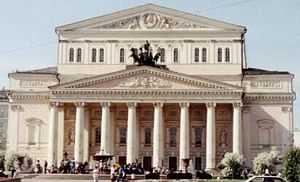
The culture of Russia is a hybrid that developed from an interplay of native Slavic cultural material with and borrowings from foreign cultures. In the Kievan period (c. 10th–13th centuries), Russia borrowed from Eastern Orthodox Byzantine culture. During the Muscovite period (c. 14th–17th centuries), Mongol hordes brought Asiatic influences. In the modern period (since the 18th century), Russia drew upon the cultural heritage of western Europe.
Russian language and culture has dominated, since Russians constitute the vast majority of the population, and because many times in the History of Russia the cultures of other nationalities were suppressed through russification.
The politics of the Soviet Union with respect to culture was controversial: on one side there was a politically-motivated desire to create a "Soviet people", which was expressed in the notion of Soviet culture, exemplified by Socialist Realism. From the other side there were periodical campaigns of preservation of national cultures: every ethnicity had "great national writers" and folk cultural practices were officially supported.
Architecture

At the time of the 1917 revolution, the population was more than 80 percent rural, living in rural villages. The Soviet period brought movement to the cities, so that by 1996, 73 percent of the population was urban, with most people living in high-rise apartment blocks constructed after the 1950s. Many urban dwellers own modest rural dachas within an hour or two of their city and on weekends work in their gardens, hike, hunt or gather in the forests, and bathe in lakes and rivers.
Cities including Moscow, Novgorod, Pskov, and Yaroslavl grew around old fortresses (kremlins) and monasteries, so reflect their complex histories through the coexistence of multiple styles — Byzantine churches from the thirteenth and fourteenth centuries stand by modernist high-rises, with Renaissance, Baroque, or Neoclassical architecture nearby.
The great churches of Kievan Rus', built after the adoption of Christianity in 988, were the first examples of monumental architecture in the East Slavic lands. The architectural style of the Kievan state which quickly established itself was strongly influenced by the Byzantine.
The fourteenth-century churches of Muscovy are sparse, and their dating is disputed. Typical monuments—found in Nikolskoe village near Ruza (1320s?) and Kolomna (1310s?)—are diminutive single-domed fortified churches built of roughly-hewn ("wild") stone and capable of withstanding brief sieges. By the time of the construction of the Assumption Cathedral in Zvenigorod (1399?), the Muscovite masons managed to regain the mastery of the pre-Mongolian builders and solved some of the construction problems that had puzzled their ancestors. Signature monuments of early Muscovite architecture are to be found in the Holy Trinity Lavra (1423), Savvin Monastery of Zvenigorod (1405?), and St. Andronik Monastery in Moscow (1427).
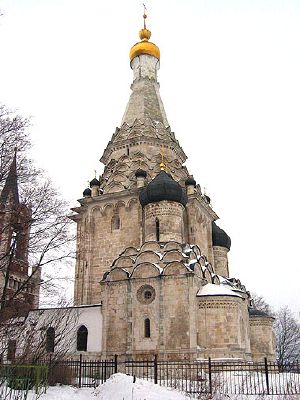
In the sixteenth century, the key development was the introduction of tented roof into brick architecture. Tent-like roof construction is thought to have originated in the Russian North, as it prevented snow from piling up on wooden buildings during long winters. In wooden churches (even modern ones) this type of roof has been very popular.
The first ever tent-like church built in brick is the Ascension church of Kolomenskoe (1531), designed to commemorate the birth of Ivan the Terrible.
Seventeenth-century Moscow churches are also profusely decorated, but their size is much smaller. The Patriarch Nikon encouraged building of fairy-like ecclesiastical residences, such as the Rostov Kremlin on the Nero Lake, with five tall churches, innumerable towers, palaces, and chambers. Nikon personally designed his new residence at the New Jerusalem Monastery which was dominated by a rotunda-like cathedral, the first of its type in Russia.
In 1712, Peter I of Russia moved the capital from Moscow to St Petersburg, which he planned to design in the Dutch style usually called Petrine baroque. Its major monuments include the Peter and Paul Cathedral, Menshikov Palace, and the Menshikov Tower.
Catherine the Great patronized neoclassical architects invited from Scotland and Italy. Some of the most representative buildings from her reign are the Alexander Palace by Giacomo Quarenghi and the Trinity Cathedral of the Alexander Nevsky Lavra by Ivan Starov. During Catherine's reign, the Russian Gothic Revival style was developed by Vasily Bazhenov and Matvei Kazakov in Moscow.
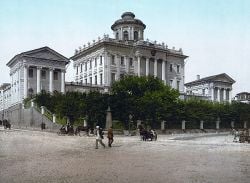
Alexander I of Russia favoured the Empire Style, as evidenced by the Kazan Cathedral, the Admiralty, the Bolshoi Theatre, St Isaac's Cathedral, and the Narva Triumphal Gates. Later, the nineteenth century saw a revival of traditional Russian architecture. The redevelopment of the centre of Moscow saw the Neo-Byzantine construction of the Great Kremlin Palace (1838-49), the Kremlin Armoury (1844-1851) and the Cathedral of Christ the Saviour (1832-1883), all designed by Konstantin Ton.
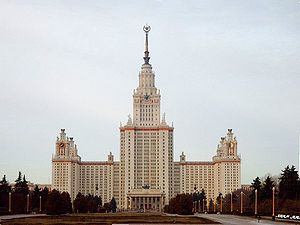
Stalinist architecture put a premium on conservative monumentalism. In the 1930's, there was rapid urbanisation as a result of Stalin's policies. There was an international competition to build the Palace of the Soviets in Moscow in that decade.
After 1945, the focus was on rebuilding the buildings destroyed in World War II but also erecting new ones: seven high-rise buildings were built at symbolic points in Moscow's space. The building of Moscow University (1948-1953) by Lev Rudnev and associates is particularly notable for its use of space. Another notable example is the Exhibition Centre in Moscow which was built for the second All-Union Agricultural Exhibition (VSKhV) in 1954, that featured a series of pavilions each decorated in the style of the feature that they represent. The other famous examples are the stations of the Moscow Metro and Saint Petersburg Metro's that were built during the 1940s and 1950s are world famous for their extravagant designs and vivid decorations. In general the Stalinist architecture completely changed the way many post-war cities look, and mostly survive to this day in central avenues and public buildings.
In terms of simpler buildings, then 1960s are mostly remembered for their massive housing plans. A new typical project was developed using nothing but concrete panels to make a simple five-story house. These Pyatietazhki became the most dominant housing constructions. Although rapidelly built, the quality was in nothing compared to earlier housing and their almost identical look contributed to the grey and dull stereotype of socialist cities.
As the Soviet Union fell apart many of its projects were put on hold, and some cancelled altogether. However for the first time, there was no longer any control over what theme or how high a building should be. As a result, and with generally improving financial conditions, architecture blossomed in unbelieving rates. For the first time modern methods of skyscraper buildings were implemented and resulted in an ambitious business centre being built in Moscow Moscow-City.
Art
Cinema
Russian filmmaking came to prominence during the 1920s when it explored editing as the primary mode of cinematic expression, resulted in world-renowned films such as Battleship Potemkin. This outburst of creativity and innovation was short-lived, however. In the 1930s, Soviet censorship stifled creativity, though it did produce the hit Chapaev. Later Soviet-era filmmakers, most notably Sergei Eisenstein and Andrei Tarkovsky, would become some of the world's most innovative and influential directors. Russian cinema has been transformed since the dissolution of the Soviet Union. During the 1990s, Russian filmmaking decreased sharply, but recent years have brought increased viewership and subsequent prosperity to the industry through exploration of contemporary subjects.
Clothing
Cuisine
Literature

Russian literature is considered to be among the most influential literature in the world. Russia has a rich literary history, beginning with the poet Alexander Pushkin, considered the greatest Russian poet and often described as the "Russian Shakespeare".[34] In the nineteenth century Russian literature underwent an astounding golden age, beginning with the poet Pushkin and culminating in two of the greatest novelists in world literature, Leo Tolstoy and Fyodor Dostoevsky. Russia has remained a leading nation in literature since that time. Significant Russian writers of the Soviet period were Boris Pasternak, Alexander Solzhenitsyn, Vladimir Mayakovski, Mikhail Sholokhov, and the poets Yevgeny Yevtushenko and Andrei Voznesensky. In the field of the novel, Tolstoy and Dostoevsky in particular were titanic figures, and have remained internationally renowned, to the point that many scholars have described one or the other as the greatest novelist ever.[35]
Music
Russia is a large and culturally diverse country with dozens of ethnic groups; each with their own forms of folk music. Music in 19th century Russia was defined by the tension between classical composer Mikhail Glinka and his followers, who embraced a Russian national identity and added religious and folk elements to their compositions, and the Russian Musical Society led by composers Anton and Nikolay Rubinstein, which was musically conservative. The later Romantic tradition of Tchaikovsky was brought into the 20th century by Sergei Rachmaninoff. During the Soviet Era, music was highly scrutinized and kept within certain boundaries of content and innovation; notable composers included Stravinsky, Prokofiev, and Shostakovich.
Ballet
Russia has a revered and recognised tradition of ballet. Russian composer Pyotr Ilyich Tchaikovsky composed the most famous works of ballet - Swan Lake, The Nutcracker, and Sleeping Beauty. During the early 20th century, Russian dancers Anna Pavlova and Vaslav Nijinsky rose to fame, and Ballets Russes' travels abroad profoundly influenced the development of dance worldwide for decades to come.[36] Soviet ballet continued the 19th-century traditions,[36] and the Bolshoi Ballet in Moscow and the Kirov in St. Petersburg remain famous throughout the world.[36]
Sports
Russia is a keen sporting country, successful at a number of sports and continuously finishing in the top rankings at the Olympic games. During the Soviet era the team placed first in the total number of medals won at 14 of its 18 appearances;[37] with these performances, the USSR was the dominant Olympic power of its era.[38] Since the Olympic Games in Helsinki in 1952 and continuing today, the Soviet and later Russian athletes never went below third place in the world, in number and gold medals collected at the Summer Olympics. The 1980 Summer Olympic Games were held in Moscow while the 2014 Winter Olympics will be hosted by Sochi. Among the most played sports are football and ice hockey.[39] Where football is played more as a pastime than professionally, Russia's ice hockey team has a long history of traditions and success, and today more than 70 Russians play in the NHL. Figure skating is another popular sport; in the 1960s the Soviet Union rose to become a dominant power in figure skating, especially in pairs skating and ice dancing. At every Winter Olympics from 1964 until the present day, a Soviet or Russian pair has won gold, often considered the longest winning streak in modern sports history. Since the end of the Soviet era tennis has grown in popularity and Russia has produced a number of famous tennis players. Chess is a favourite pastime, and a sport that has been dominated by Russians in the post-war (1945-) era. The winner of the 1948 World Chess Championship, Russian Mikhail Botvinnik, started an era of Soviet dominance in the chess world. Until the end of the Soviet Union, there was only one non-Soviet champion. Other sports widely played in Russia include weightlifting, gymnastics, boxing, wrestling, martial arts, volleyball, basketball and skiing.
ReferencesISBN links support NWE through referral fees
- Esther Jacobson, The Art of the Scythians: The Interpenetration of Cultures at the Edge of the Hellenic World, Brill, 1995, p. 38. ISBN 9004098569.
- Gocha R. Tsetskhladze (ed), The Greek Colonisation of the Black Sea Area: Historical Interpretation of Archaeology, F. Steiner, 1998, p. 48. ISBN 3515073027.
- Christian>David Christian, A History of Russia, Central Asia and Mongolia, Blackwell Publishing, 1998, pp. 286–288. ISBN 0631208143.
- Paul M. Barford, The Early Slavs, Cornell University Press, 2001, pp. 15-16. ISBN 0801439779.
- Henry K Paszkiewicz, The Making of the Russian Nation, Darton, Longman & Todd, 1963, p. 262.
- Dimitri Obolensky, Byzantium and the Slavs, St Vladimir's Seminary Press, 1994, p. 42. ISBN 088141008X.
- Serhii Plokhy, The Origins of the Slavic Nations: Premodern Identities in Russia, Ukraine, and Belarus, Cambridge University Press, 2006, p. 13. ISBN 0521864038.
- Russell Bova, Russia and Western Civilization: Cultural and Historical Encounters, M.E. Sharpe, 2003, p. 13. ISBN 0765609762.
- Michael Franklin Hamm, Kiev: A Portrait, 1800-1917, Princeton University Press, 1993. ISBN 0691025851.
- David Nicolle, Kalka River 1223: Genghiz Khan's Mongols Invade Russia, Osprey Publishing, 2001. ISBN 1841762334.
- Janet Martin, Medieval Russia, 980-1584, Cambridge University Press, 1995, p. 139. ISBN 052136832.
- Donald Ostrowski in The Cambridge History of Russia, Cambridge University Press, 2006, p. 234. ISBN 0521812275.
- Janet Martin, Medieval Russia, 980-1584, Cambridge University Press, 1995, p. 395. ISBN 052136832.
- Chester S L Dunning, Russia's First Civil War: The Time of Troubles and the Founding of the Romanov Dynasty, p. 434] Penn State Press, 2001, ISBN 0-271-02074-1</ref>
- Jarmo Kotilaine and Marshall Poe, Modernizing Muscovy: Reform and Social Change in Seventeenth-Century Russia, Routledge, 2004, p. 264. ISBN 0415307511.
- Fairbanks, Jr., Charles H. 1999. "The Feudalization of the State". Journal of Democracy 10(2):47–53.
Footnotes
- ↑ Cite error: Invalid
<ref>tag; no text was provided for refs namedFrank - ↑ Cite error: Invalid
<ref>tag; no text was provided for refs namedHamm - ↑ 3.0 3.1 3.2 3.3 3.4 3.5 3.6 3.7 3.8 3.9 "Russia." MSN Encarta. <http://encarta.msn.com/encyclopedia_761569000_20/Russia.html>.
- ↑ Lenin, Vladimir (1917). The State and Revolution.
- ↑ Archive of Lenin's works. marxists.org
- ↑ 6.0 6.1 Union of Soviet Socialist Republics MSN Encarta
- ↑ 7.0 7.1 "Russia." Britannica Student Encyclopedia. 2007. Encyclopædia Britannica Online. 2 July 2007 <http://www.britannica.com/ebi/article-207580>
- ↑ Richman, Sheldon (1981). War Communism to NEP: The Road to Serfdom. The Journal of Libertarian Studies 5 (1): 89-97.
- ↑ Case Study: Soviet Prisoners-of-War (POWs), 1941-42. Gendercide Watch. Retrieved 2007-07-22.
- ↑ "Soviet Casualties and Combat Losses in the Twentieth Century", Greenhill Books, London, 1997, G. F. Krivosheev
- ↑ Christian Streit: Keine Kameraden: Die Wehrmacht und die Sowjetischen Kriegsgefangenen, 1941-1945, Bonn: Dietz (3. Aufl., 1. Aufl. 1978), ISBN 3801250164
- ↑ Osbourne, Andrew, World leaders gather as Russia remembers. The Age
- ↑ Rozhnov, Konstantin, Who won World War II?. BBC. Russian historian Valentin Falin
- ↑ Andreev, EM, et al, Naselenie Sovetskogo Soiuza, 1922-1991. Moscow, Nauka, 1993. ISBN 5-02-013479-1
- ↑ Mark Harrison, The Economics of World War II: Six Great Powers in International Comparison, Cambridge University Press, 1998, p. 291 (ISBN 0521785030), for more information.
- ↑ Wolf, Julie. Mikhail Gorbachev Public Broadcasting Service. "At 54, younger and healthier than his predecessors, the reform-minded Gorbachev was openly critical of Party excesses".
- ↑ 17.00 17.01 17.02 17.03 17.04 17.05 17.06 17.07 17.08 17.09 17.10 [1]. Nuffield Poultry Study Group - Visit to Russia, pg 7
- ↑ Union of Soviet Socialist Republics MSN Encarta, pg 14
- ↑ Russia pays off USSR’s entire debt, sets to become crediting country Pravda.ru - Russian News & Analysis
- ↑ Nicholson, Alex, Russia metals bonanza raises hopes, fears. latimes.com
- ↑ Roaf, James (European II Department, IMF), Corruption in Russia Conference on Post-Election Strategy Moscow, April 5-7, 2000, International Monetary Fund
- ↑ [2] "Furthermore, Khodorkovsky was considered a part of the Yeltsin-era "crony capitalism"—a freewheeling combination of politically active billionaire "oligarchs" and Boris Yeltsin's family members, who are now being purged"
- ↑ Sahadi, Jeanne, Moscow remains the world’s most expensive city while London moves up from fifth to second place. CNNMoney.com
- ↑ 24.0 24.1 24.2 24.3 24.4 24.5 24.6 24.7 24.8 24.9 Cite error: Invalid
<ref>tag; no text was provided for refs namedcia - ↑ (Russian), Стенограмма пресс-конференции Президента России Владимира Путина. Часть I
- ↑ Members APEC Study Center; City University of Hong Kong
- ↑ International Reserves assets1 of the Russian Federation in 2007 The Central Bank of the Russian Federation
- ↑ Russia's GDP to grow by 7% in 2007: IMF russiatoday.ru
- ↑ (Russian), Уровень жизни населения. Federal State Statistics Service
- ↑ Statement by John Lipsky, First Deputy Managing Director of the International Monetary Fund International Monetary Fund, Press Release No. 07/126
- ↑ Russia's foreign debt down 31.3% in Q3 - finance ministry Russian News & Information Agency
- ↑ 32.0 32.1 Stabilization fund of the Russian Federation Russian Ministry of Finance
- ↑ Schofield, James, Russia's oil renaissance. BBC News
- ↑ "Russia." Britannica Student Encyclopedia. 2007. Encyclopædia Britannica Online. 3 July 2007 <http://www.britannica.com/ebi/article-207547>.
- ↑ "Russian literature." Encyclopædia Britannica. 2007. Encyclopædia Britannica Online. 16 July 2007 <http://www.britannica.com/eb/article-29157>.
- ↑ 36.0 36.1 36.2 "Russia." Britannica Student Encyclopedia. 2007. Encyclopædia Britannica Online. 3 July 2007 <http://www.britannica.com/ebi/article-207552>.
- ↑ Summer Olympics Through The Years. Infoplease.com
- ↑ The main game in a dragon's lair Sydney Morning Herald
- ↑ Russian Sport Activities Russia.com
Bibliography
|
Overall histories
Pre-revolutionary Russia
Soviet era
Post-Soviet era
|
Climate
Language
|
External links
- Russia World Fact Book 2007, accessed August 18, 2007.
- Culture of Russia Countries and Their Cultures No-Sa, accessed August 19, 2007.
- Russia Profile - In-depth coverage of international, cultural, business and political events in Russia
- RussiaMap.org - Maps of Russia
- RussiaBlog.org - News & Commentary on current affairs in Russia
- The St.Petersburg Outdoor Train Museum [3]
- Steam Locomotives on Sakhalin Island [4]
Government resources
- Duma - Official site of the parliamentary lower house (Russian)
- Federative Council - Official site of the parliamentary upper house
- Kremlin - Official presidential site
- Gov.ru - Official governmental portal (Russian)
- Russian Federation Today - Official issue of the Federal Assembly (Russian)
- Ministry of Foreign affairs
- Russian Federal Customs Service
- Central Bank of Russia
- World Security Institute's Johnson's Russia List
- Russian News Agency Ria Novosti
- Russian Space Program
Other resources
- Russia photo gallery and city guide
- (Russian) Culture of Russia - with support of Federal Agency for Culture and Cinematography
- Encyclopaedia Britannica's Country Portal site
- BBC Country Profile - Russia
- RussGUS Bibliographic database of German publications on Russia (about 175 000 positions)
- Way to Russia - Guide to Russia
- CIA World Factbook - Russia
- News From Russia
- U.S. State Department Consular Information Sheet: Russia
- Russia Energy Resources and Industry from U.S. Department of Energy
- Russia History Timeline 1533 - 1991
- Russia's State Symbols
| Geographic locale |
|
Template:Countries of the Baltic region Countries of Europe
Albania · Andorra · Armenia2 · Austria · Azerbaijan1 · Belarus · Belgium · Bosnia and Herzegovina · Bulgaria · Croatia · Cyprus2 · Czech Republic · Denmark3 · Estonia · Finland · France3 · Georgia1 · Germany · Greece · Hungary · Iceland · Ireland · Italy · Kazakhstan1 · Latvia · Liechtenstein · Lithuania · Luxembourg · Republic of Macedonia · Malta · Moldova · Monaco · Montenegro · Netherlands3 · Norway3 · Poland · Portugal · Romania · Russia1 · San Marino · Serbia · Slovakia · Slovenia · Spain3 · Sweden · Switzerland · Turkey1 · Ukraine · United Kingdom3 · Vatican City 1 Has majority of its territory in Asia. 2 Entirely in Asia but having socio-political connections with Europe. 3 Has dependencies or similar territories outside Europe. Countries of Asia
Afghanistan · Armenia · Azerbaijan1 · Bahrain · Bangladesh · Bhutan · Brunei · Cambodia · China, People's Republic of · China, Republic of (Taiwan)2 · Cyprus · Egypt3 · Georgia1 · India · Indonesia4 · Iran · Iraq · Israel · Japan · Jordan · Kazakhstan1 · Korea, Democratic People's Republic of · Korea, Republic of · Kuwait · Kyrgyzstan · Laos · Lebanon · Malaysia · Maldives · Mongolia · Myanmar · Nepal · Oman · Pakistan · Philippines · Qatar · Russia1 · Saudi Arabia · Singapore · Sri Lanka · Syria · Tajikistan · Thailand · Timor-Leste (East Timor)4 · Turkey1 · Turkmenistan · United Arab Emirates · Uzbekistan · Vietnam · Yemen3 For dependent and other territories, see Dependent territory and List of unrecognized countries.
1 Partly or significantly in Europe.
2 The Republic of China (Taiwan) is not officially recognized by the United Nations; see Political status of Taiwan. Template:Countries bordering the Black Sea Template:Countries bordering the Caspian Sea |
| International organizations | |||||||||||||||||||||||||||||||||||||||||||||||||||||||||||||||||||||||||||||||||||
Template:Council of Europe
Template:BRIC
Template:Black Sea Naval Co-operation Task Group (BLACKSEAFOR) Member states of the East Asia Summit (EAS)
Potential future members
Template:Organization of the Black Sea Economic Cooperation (BSEC) Template:Shanghai Cooperation Organisation
| |||||||||||||||||||||||||||||||||||||||||||||||||||||||||||||||||||||||||||||||||||
Credits
New World Encyclopedia writers and editors rewrote and completed the Wikipedia article in accordance with New World Encyclopedia standards. This article abides by terms of the Creative Commons CC-by-sa 3.0 License (CC-by-sa), which may be used and disseminated with proper attribution. Credit is due under the terms of this license that can reference both the New World Encyclopedia contributors and the selfless volunteer contributors of the Wikimedia Foundation. To cite this article click here for a list of acceptable citing formats.The history of earlier contributions by wikipedians is accessible to researchers here:
The history of this article since it was imported to New World Encyclopedia:
Note: Some restrictions may apply to use of individual images which are separately licensed.


